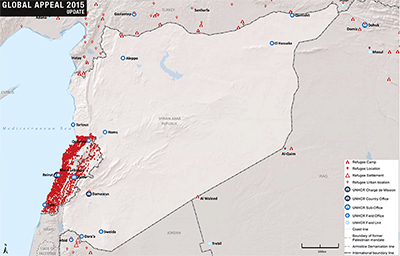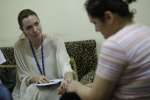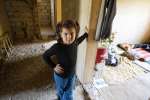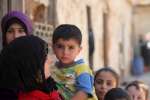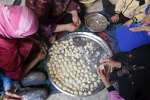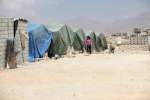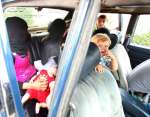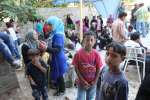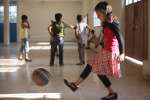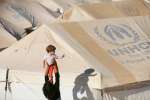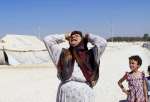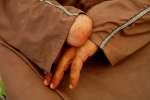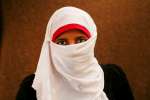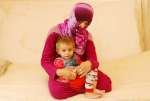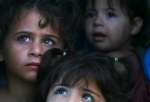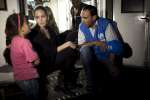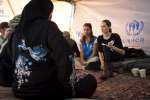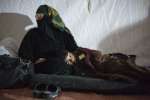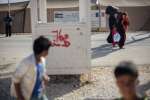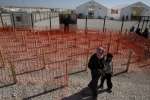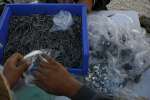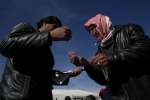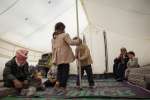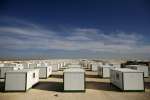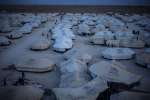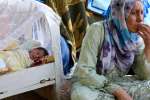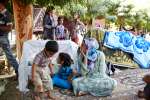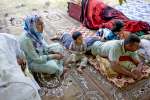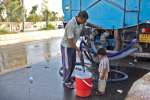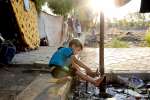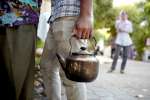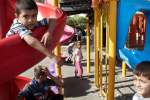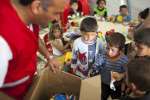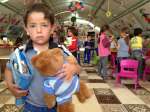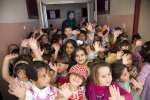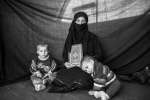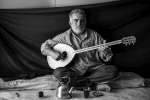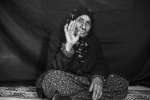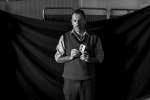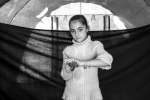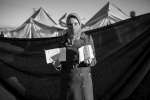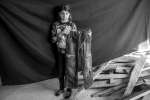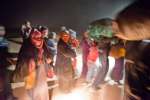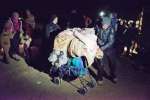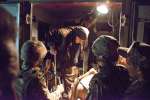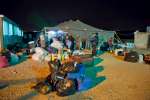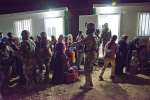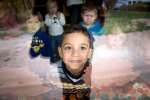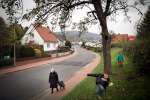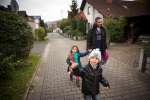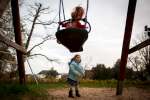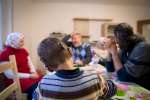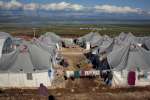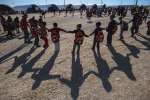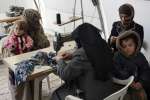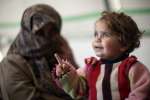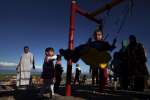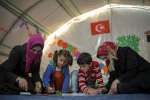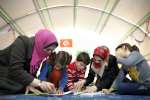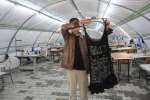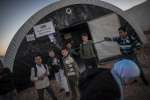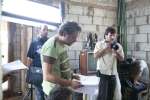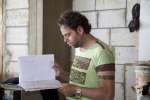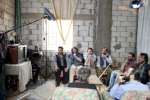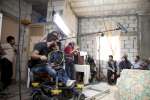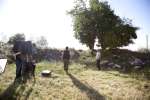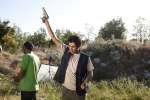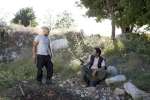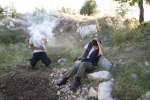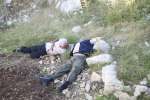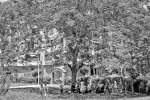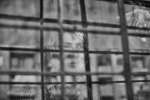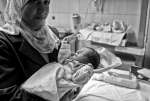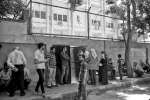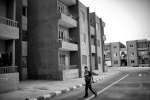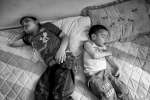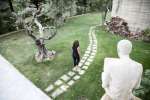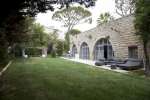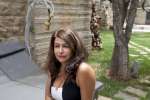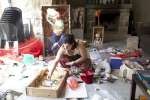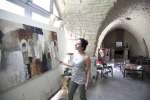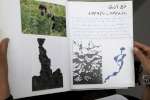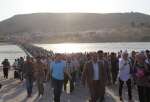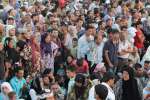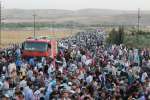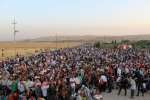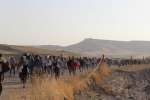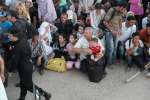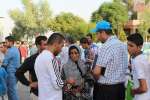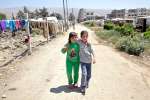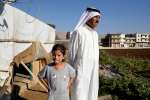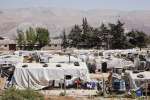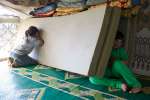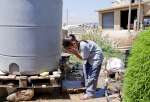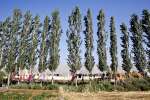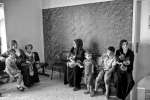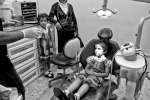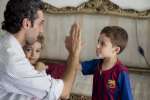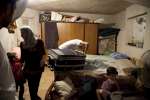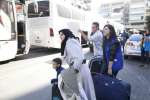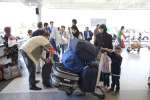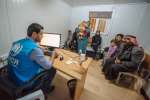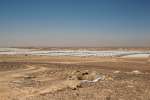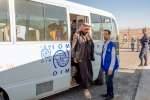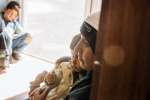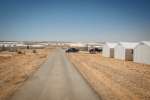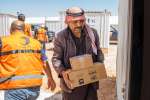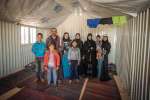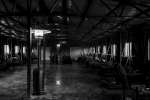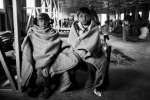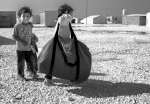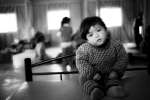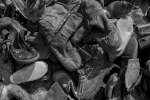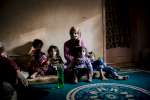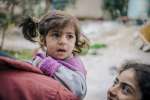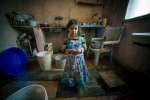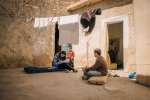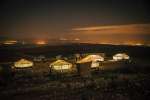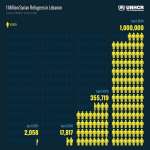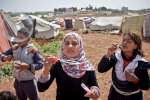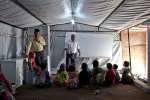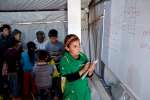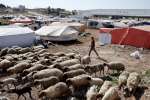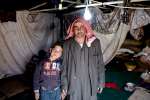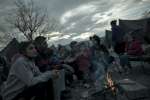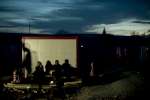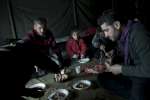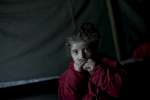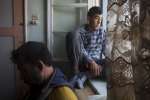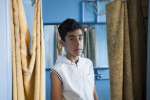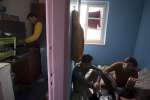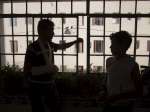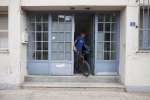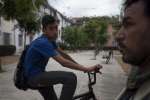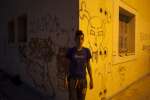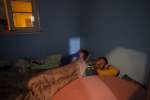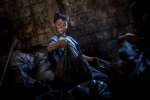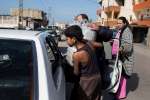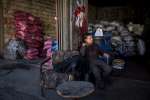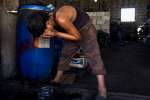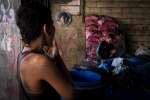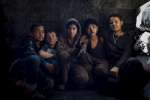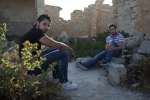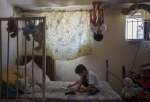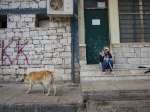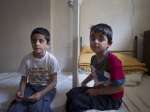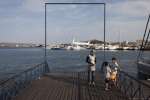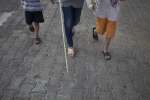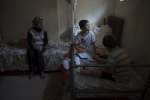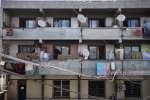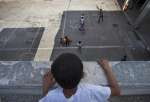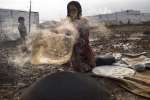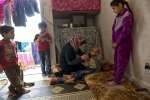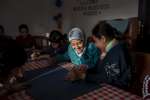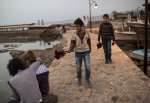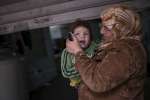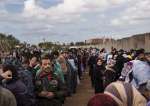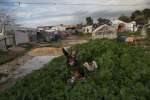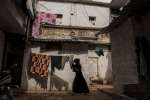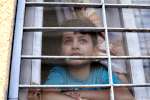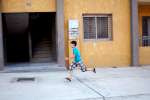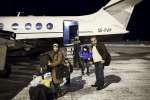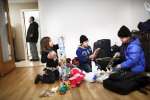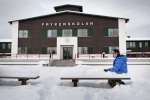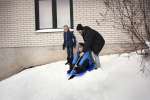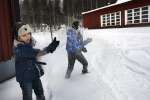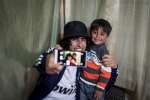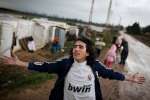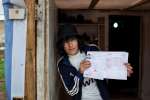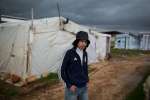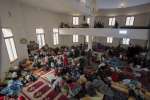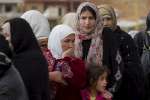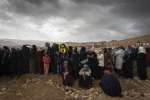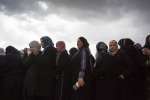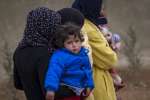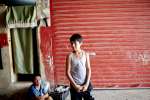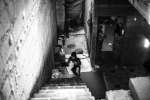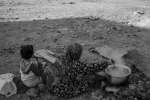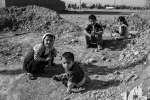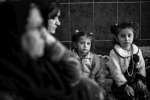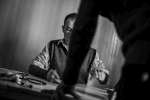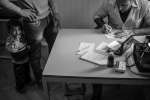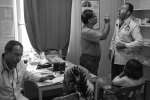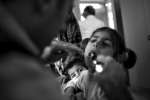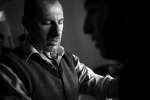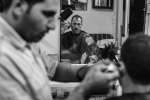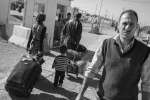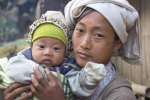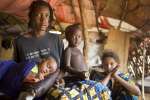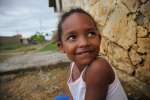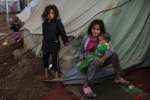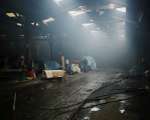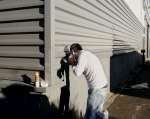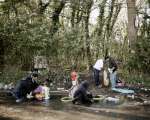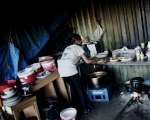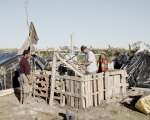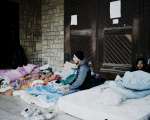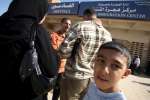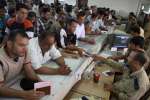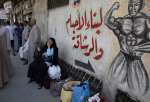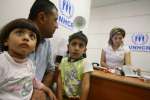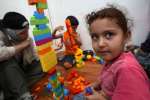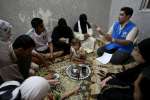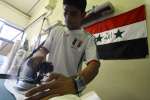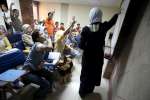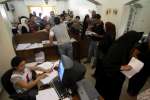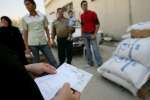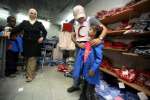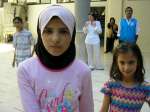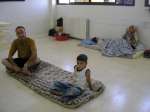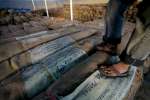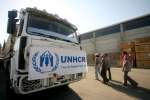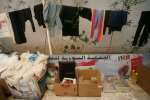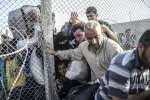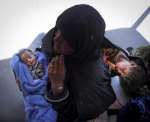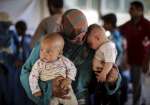UNHCR contact information
|
| Residing in Syrian Arab Republic [1] |
|---|
| Refugees [2] |  149,140 Refugee figure for Iraqis in the Syrian Arab Republic is a Government estimate. UNHCR has registered and is assisting 30,000 Iraqis at end-2014. |
|---|
| Asylum Seekers [3] | 2,745 |
|---|
| Returned Refugees [4] | 0 |
|---|
| Internally Displaced Persons (IDPs) [5] | 7,632,500 |
|---|
| Returned IDPs [6] | 0 |
|---|
| Stateless Persons [7] | 160,000 |
|---|
| Various [8] | 3,270 |
|---|
| Total Population of Concern | 7,947,655 |
|---|
| Originating from Syrian Arab Republic [1] |
|---|
| Refugees [2] | 3,883,585 |
|---|
| Asylum Seekers [3] | 79,670 |
|---|
| Returned Refugees [4] | 0 |
|---|
| Internally Displaced Persons (IDPs) [5] | 7,632,500 |
|---|
| Returned IDPs [6] | 0 |
|---|
| Various [8] | 1,993 |
|---|
| Total Population of Concern | 11,597,748 |
|---|
UNHCR Goodwill Ambassador Angelina Jolie meets Iraqi refugees in Syria
UNHCR Goodwill Ambassador Angelina Jolie returned to the Syrian capital Damascus on 2 October, 2009 to meet Iraqi refugees two years after her last visit. The award-winning American actress, accompanied by her partner Brad Pitt, took the opportunity to urge the international community not to forget the hundreds of thousands of Iraqi refugees who remain in exile despite a relative improvement in the security situation in their homeland. Jolie said most Iraqi refugees cannot return to Iraq in view of the severe trauma they experienced there, the uncertainty linked to the coming Iraqi elections, the security issues and the lack of basic services. They will need continued support from the international community, she said. The Goodwill Ambassador visited the homes of two vulnerable Iraqi families in the Jaramana district of southern Damascus. She was particularly moved during a meeting with a woman from a religious minority who told Jolie how she was physically abused and her son tortured after being abducted earlier this year in Iraq and held for days. They decided to flee to Syria, which has been a generous host to refugees.
UNHCR Goodwill Ambassador Angelina Jolie meets Iraqi refugees in Syria
Syrian Refugees in Lebanon
As world concern grows over the plight of hundreds of thousands of displaced Syrians, including more than 200,000 refugees, UNHCR staff are working around the clock to provide vital assistance in neighbouring countries. At the political level, UN High Commissioner for Refugees António Guterres was due on Thursday (August 30) to address a closed UN Security Council session on Syria.
Large numbers have crossed into Lebanon to escape the violence in Syria. By the end of August, more than 53,000 Syrians across Lebanon had registered or received appointments to be registered. UNHCR's operations for Syrian refugees in Tripoli and the Bekaa Valley resumed on August 28 after being briefly suspended due to insecurity.
Many of the refugees are staying with host families in some of the poorest areas of Lebanon or in public buildings, including schools. This is a concern as the school year starts soon. UNHCR is urgently looking for alternative shelter. The majority of the people looking for safety in Lebanon are from Homs, Aleppo and Daraa and more than half are aged under 18. As the conflict in Syria continues, the situation of the displaced Syrians in Lebanon remains precarious.
Syrian Refugees in Lebanon
Turkish Camps Provide Shelter to 90,000 Syrian Refugees
By mid-September, more than 200,000 Syrian refugees had crossed the border into Turkey. UNHCR estimates that half of them are children, and many have seen their homes destroyed in the conflict before fleeing to the border and safety.
The Turkish authorities have responded by building well-organized refugee camps along southern Turkey's border with Syria. These have assisted 120,000 refugees since the crisis conflict erupted in Syria. There are currently 12 camps hosting 90,000 refugees, while four more are under construction. The government has spent approximately US$300 million to date, and it continues to manage the camps and provide food and medical services.
The UN refugee agency has provided the Turkish government with tents, blankets and kitchen sets for distribution to the refugees. UNHCR also provides advice and guidelines, while staff from the organization monitor voluntary repatriation of refugees.
Most of the refugees crossing into Turkey come from areas of northern Syria, including the city of Aleppo. Some initially stayed in schools or other public buildings, but they have since been moved into the camps, where families live in tents or container homes and all basic services are available.
Turkish Camps Provide Shelter to 90,000 Syrian Refugees
Angelina Jolie visits Syrian and Iraqi refugees in the Middle East
In her new role as UNHCR Special Envoy, Angelina Jolie has made five trips to visit refugees so far this year. She travelled to Jordan, Lebanon and Turkey in September 2012 to meet some of the tens of thousands of Syrians who have fled conflict in their homeland and sought shelter in neighbouring countries. Jolie wrapped up her Middle East visit in Iraq, where she met Syrian refugees in the north as well as internally displaced Iraqis and refugee returnees to Baghdad.
The following unpublished photos were taken during her visit to the Middle East and show her meeting with Syrian and Iraqi refugees.
Angelina Jolie visits Syrian and Iraqi refugees in the Middle East
Displaced inside Syria: UNHCR and its Dedicated Staff help the Needy
The violence inside Syria continues to drive people from their homes, with some seeking shelter elsewhere in their country and others risking the crossing into neighbouring countries. The United Nations estimates that up to 4 million people are in need of help, including some 2 million believed to be internally displaced.
The UN refugee agency has 350 staff working inside Syria. Despite the insecurity, they continue to distribute vital assistance in the cities of Damascus, Aleppo, Al Hassakeh and Homs. Thanks to their work and dedication, more than 350,000 people have received non-food items such as blankets, kitchen sets and mattresses. These are essential items for people who often flee their homes with no more than the clothes on their backs. Cash assistance has been given to more than 10,600 vulnerable Syrian families.
Displaced inside Syria: UNHCR and its Dedicated Staff help the Needy
Refugees prepare for winter in Jordan's Za'atari camp
Life in Jordan's Za'atari refugee camp is hard. Scorching hot in the summer and freezing cold in the winter, this flat, arid patch of land near the border with Syria was almost empty when the camp opened in July. Today, it hosts more than 31,000 Syrians who have fled the conflict in their country.
The journey to Jordan is perilous. Refugees cross the Syrian-Jordan border at night in temperatures that now hover close to freezing. Mothers try to keep their children quiet during the journey. It is a harrowing experience and not everyone makes it across.
In Za'atari, refugees are allocated a tent and given sleeping mats, blankets and food on arrival. But as winter approaches, UNHCR is working with partners to ensure that all refugees will be protected from the elements. This includes upgrading tents and moving the most vulnerable to prefabricated homes, now being installed.
Through the Norwegian Refugee Council, UNHCR has also distributed thousands of winter kits that include thermal liners, insulated ground pads and metal sheeting to build sheltered kitchen areas outside tents. Warmer clothes and more blankets will also be distributed where needed.
Refugees prepare for winter in Jordan's Za'atari camp
UNHCR humanitarian aid convoy reaches IDPs in Syria
The UN refugee agency at the end of January completed a first delivery of winter emergency relief to the Azzas area of northern Syria, where thousands of internally displaced people are living in makeshift camps, as well as to the Kerama camp. An eight-truck convoy transported 2,000 tents and 15,000 blankets from Latakia on the Syrian coast to an area between Aleppo and the Syrian-Turkish border. The recipients were delighted with the aid after months of suffering. The operation was possible thanks to the logistics support of the Syrian Arab Red Crescent, the agreement and cooperation of the Syrian government and facilitation by the Syrian National Coalition. This allowed the convoy to safely reach people in need, in a strictly humanitarian and non-political operation. In early February, almost 790,000 Syrians in neighbouring countries were either registered as refugees or awaiting registration. A further 4 million people inside Syria were affected by the crisis, including an estimated 2.5 million internally displaced people.
UNHCR humanitarian aid convoy reaches IDPs in Syria
An Infant's Journey to Safety
Three days after giving birth to her fourth child, a girl she named Hawler, Peroz concluded that the situation in her hometown of Hassake, Syria, was too dangerous for her children. She decided to make the difficult journey to northern Iraq. Along the way, she and Hawler were sick. "I was terrified the baby might die," said Peroz, 27.
Although the border was closed, guards felt compassion for the newborn child and let Peroz's family enter. A few days later Peroz and her children were reunited with their father and now they are living with hundreds of other refugees in a small park on the outskirts of Erbil.
Battling mosquitoes and soaring daytime temperatures, and with little more than blankets for comfort and a breakfast of bread and cheese for nourishment, Peroz and her husband hope to be transferred to a new tented settlement.
Over the past few weeks, tens of thousands of Syrians have flooded into northern Iraq, fleeing violence. With existing camps at full capacity, many refugee families are finding shelter anywhere they can. The local government has started transferring people from Qushtapa Park to a nearby camp. UNHCR is registering the refugees, as well as providing tents and life-saving assistance.
An Infant's Journey to Safety
From Paris With Love, Toys for Syrian Children
Every year, the Quai Branly Museum in Paris organizes a collection of toys from schoolchildren in Paris and, with a little help from UNHCR and other key partners, sends them to refugee children who have lost so much.
The beneficiaries this year were scores of Syrian children living in two camps in Turkey, one of the major host countries for the more than 1.4 million Syrians who have fled their country with or without their families. Most of these traumatized young people have lost their own belongings in the rubble of Syria.
Last week, staff from the museum, UNHCR and the Fédération des Associations d'Anciens du Scoutisme gathered up the toys and packed them into 60 boxes. They were then flown to Turkey by Aviation Sans Frontières (Aviation without Borders) and taken to the kindergarten and nursery schools in Nizip-1 and Nizip-2 camps near the city of Gaziantep.
A gift from more fortunate children in the French capital, the toys brought a ray of sunshine into the lives of some young Syrian refugees and reminded them that their peers in the outside world do care.
These images of the toy distribution were taken by photographer Aytac Akad and UNHCR's Selin Unal.
From Paris With Love, Toys for Syrian Children
The Most Important Thing: Syrian Refugees
What would you bring with you if you had to flee your home and escape to another country? More than 1 million Syrians have been forced to ponder this question before making the dangerous flight to neighbouring Jordan, Lebanon, Turkey, Iraq or other countries in the region.
This is the second part of a project by photographer Brian Sokol that asks refugees from different parts of the world, "What is the most important thing you brought from home?" The first instalment focused on refugees fleeing from Sudan to South Sudan, who openly carried pots, water containers and other objects to sustain them along the road.
By contrast, people seeking sanctuary from the conflict in Syria must typically conceal their intentions by appearing as though they are out for a family stroll or a Sunday drive as they make their way towards a border. Thus they carry little more than keys, pieces of paper, phones and bracelets - things that can be worn or concealed in pockets. Some Syrians bring a symbol of their religious faith, others clutch a reminder of home or of happier times.
The Most Important Thing: Syrian Refugees
Refuge on the Sixth Floor: Urban Refugees in Jordan
For most people, the iconic image of refugees is thousands of people living in row upon row of tents in a sprawling emergency camp in the countryside. But the reality today is that more than half of the world's refugees live in urban areas, where they face many challenges and where it is more difficult to provide them with protection and assistance.
That's the case in Jordan, where tens of thousands of Syrian refugees have bypassed camps near the border and sought shelter in towns and cities like Amman, the national capital. The UN refugee agency is providing cash support to some 11,000 Syrian refugee families in Jordan's urban areas, but a funding shortage is preventing UNHCR from providing any more.
In this photo set, photographer Brian Sokol, follows eight families living on the sixth floor of a nondescript building in Amman. All fled Syria in search of safety and some need medical care. The images were taken as winter was descending on the city. They show what it is like to face the cold and poverty, and they also depict the isolation of being a stranger in a strange land.
The identities of the refugees are masked at their request and their names have been changed. The longer the Syria crisis remains unresolved, the longer their ordeal - and that of more than 1 million other refugees in Jordan and other countries in the region.
Refuge on the Sixth Floor: Urban Refugees in Jordan
Flight by Night: Syrian Refugees Risk the Crossing to Jordan in the Dark
Every night, hundreds of refugees flee from Syria via dozens of unofficial border crossing points and seek shelter in neighbouring Jordan. Many feel safer crossing in the dark, but it remains a risky journey by day or night. They arrive exhausted, scared and traumatized, but happy to be in the welcoming embrace of Jordan and away from the conflict in their country. Some arrive with bad injuries, many carry belongings. A large proportion are women and children. Observers at the border at night see these eerie silhouettes approaching out of the dark. Earlier this week, UN High Commissioner for Refugees António Guterres was among these observers. He and his UNHCR colleagues were moved by what they saw and heard at the border and earlier in Za'atri refugee camp, where arrivals are taken by the Jordanian military. The majority of the Syrian refugees move to Jordan's cities, towns and villages. Guterres has urged donors to set up special funds for the Syria crisis, warning of disaster if more humanitarian funding is not forthcoming soon. Photographer Jared Kohler was at the border when Guterres visited. These are his images.
Flight by Night: Syrian Refugees Risk the Crossing to Jordan in the Dark
Abdu finds his voice in Germany
When bombs started raining down on Aleppo, Syria, in 2012, the Khawan family had to flee. According to Ahmad, the husband of Najwa and father of their two children, the town was in ruins within 24 hours.
The family fled to Lebanon where they shared a small flat with Ahmad's two brothers and sisters and their children. Ahmad found sporadic work which kept them going, but he knew that in Lebanon his six-year-old son, Abdu, who was born deaf, would have little chance for help.
The family was accepted by Germany's Humanitarian Assistance Programme and resettled into the small central German town of Wächtersbach, near Frankfurt am Main. Nestled in a valley between two mountain ranges and a forest, the village has an idyllic feel.
A year on, Abdu has undergone cochlear implant surgery for the second time. He now sports two new hearing aids which, when worn together, allow him to hear 90 per cent. He has also joined a regular nursery class, where he is learning for the first time to speak - German in school and now Arabic at home. Ahmed is likewise studying German in a nearby village, and in two months he will graduate with a language certificate and start looking for work. He says that he is proud at how quickly Abdu is learning and integrating.
Abdu finds his voice in Germany
Keeping Occupied in Turkey's Adiyaman camp for Syrian Refugees
Since the conflict in Syria erupted in April 2011, the government of neighbouring Turkey has established 17 camps in eight provinces to provide safety and shelter to tens of thousands of refugees - three-quarters of them women and children. The camps, including Adiyaman depicted here, provide a place to live and address the basic physical needs of the residents, but they also provide access to health care, education, vocational training and other forms of psychosocial support.
UNHCR teams are present on a regular basis in all the refugee camps and provide technical assistance to the Turkish authorities on all protection-related concerns, including registration, camp management, specific needs and vulnerabilities, and voluntary repatriation. UNHCR has contributed tents, cooking facilities and other relief items. The refugee agency is also working with the government to help an estimated 100,000 Syrian urban refugees. It will continue its material and technical support to help the authorities cope with an increase in arrivals. The following images of camp life were taken by American photographer, Brian Sokol, in Adiyaman camp, located in Turkey's Gaziantep province. At the start of February 2013, nearly 10,000 Syrian refugees were living in the camp.
Keeping Occupied in Turkey's Adiyaman camp for Syrian Refugees
Syria's Soap Makers Continue Ramadan Tradition in Lebanon
TV soap operas are a staple of Ramadan across the Arab world, and those made in Syria are particularly famous and popular around the region. The war in Syria has halted most productions, but some cast and crews are continuing the tradition and filming new dramas for the small screen in Lebanon.
In general, the stories are about Arab heroes and celebrated battles and are an integral - and highly anticipated - part of Ramadan. Acclaimed photographer Elena Dorfman, on assignment for UNHCR, followed the crews of two soaps on location in Lebanon.
In these images, she focuses on director Saifeddine Al Sibaii's making his latest soap, "Al Wilada Min Al Khasira" ("Giving birth from the hip"), and on female director Abeer Esber as she films the Ramadan drama, "Al Obour" ("The Transition") in a mountainous region of Lebanon.
Syria's Soap Makers Continue Ramadan Tradition in Lebanon
UNHCR Special Envoy Angelina Jolie meets with newly arrived Syrian refugees in Jordan
UNHCR Special Envoy Angelina Jolie traveled to Jordan's border with Syria on 18 June at the start of a visit to mark World Refugee Day. She met with refugees as they were arriving and listened to their stories of escape.She urged the international community to do more to help the survivors of the conflict and the countries hosting them. "The worst humanitarian crisis of the 21st century is unfolding in the Middle East today," she said."The international response to this crisis falls short of the vast scale of this human tragedy. Much more humanitarian aid is needed, and above all, a political settlement to this conflict must be found." The war in Syria forced more people to flee last year than any other conflict in the world. In the past six months, the number has more than doubled to 1.6 million, of whom 540,000 are in Jordan. During her visit to Jordan, Ms. Jolie will join the UN High Commissioner for Refugees, António Guterres, to meet with government officials and refugees.
UNHCR Special Envoy Angelina Jolie meets with newly arrived Syrian refugees in Jordan
Growing Numbers of Syrians Seek Refuge in Egypt
Since the Syrian crisis erupted in March 2011, more than 1.6 million Syrians have fled their homeland to escape the fighting. Most have sought shelter in countries neighbouring Syria - Iraq, Jordan, Lebanon and Turkey. But a significant number have made their way to Egypt in recent months. They are coming by air from Lebanon after leaving Syria, and also by sea. Since March, UNHCR has been registering about 2,000 a week. To date, almost 80,000 have registered as refugees, with half of them women and children. UNHCR believes there may be many more and the refugee agency is reaching out to these people so that they can receive vital protection and assistance and get access to basic services. The Syrians are staying with host families or renting apartments, mainly in urban centres such as Cairo, Sixth of October City, Alexandria and Damietta. The refugees heading to Egypt say they are attracted by its open door policy for Syrian refugees and by the lower rents and living costs. The following photographs were taken by Shawn Baldwin.
Growing Numbers of Syrians Seek Refuge in Egypt
Refugee Syrian Artists Get Some Room of their Own
When Raghad Mardini first set eyes on the crumbling, war-scarred Ottoman coach house in the mountains above Beirut she saw potential. Trained as a civil engineer in her native Syria, she knew how to put the bones back together and spent a year lovingly restoring the structure, which had been badly damaged during Lebanon's 1975-90 civil war. She also knew the potential of the rudderless young Syrian artists recently displaced by the tragic war in their country, who needed her help in navigating Beirut, where they had all fled. With the coach house finished and standing empty, she decided it would make an ideal studio and sanctuary for the young, artistic refugees. She set up the Art Residence Aley so that they could produce and create once more. Photographer Elena Dorfman, who is working for UNHCR in the Lebanon, visited the retreat in the small town of Aley. These are some of the images she took.
Refugee Syrian Artists Get Some Room of their Own
Syrians stream from their war-torn country into Iraq's Kurdistan region
Thousands of Syrians streamed across a bridge over the Tigris River and into Iraq's Kurdistan region on Thursday, August 15th. UNHCR Field Officer, Galiya Gubaeva, was on the ground with her camera.
Syrians stream from their war-torn country into Iraq's Kurdistan region
Syria's Latest Grim Statistic: One Million Children in Exile
With Syria's civil war well into its third year, the United Nations estimates that there are now more than 1 million Syrian children living outside their country as refugees. They include eight-year-old Aya, who was forced to flee with her family to Lebanon in 2011. They now live in an informal settlement with more than a thousand other refugees, surrounded by tomato, pepper and carrot fields in the fertile Bekaa Valley. The young girl is curious about everything and loves to learn, but she hasn't been able to go to school for most of the past two years. She dreams of studying and wants to become a paediatrician one day. But her father is sick and unemployed and cannot afford the monthly fee of US$20 for the bus to the nearest school. While her siblings work in the fields to make money, Aya stays behind to care for her sister Labiba, aged 11, who lives with disability. Her family says Aya is tough, but also has a very sunny disposition that rubs off on others.
Syria's Latest Grim Statistic: One Million Children in Exile
Kuwaiti Funds Provide Vital Medical Aid for Syrians in Lebanon
As the number of Syrian refugees in Lebanon continues to grow, ensuring access to quality health care is becoming an increasing challenge for humanitarian aid groups and the international community. So, Kuwait's unprecedented donation in April of US$110 million for UNHCR's Syria crisis operations this year came at a most opportune time. Slightly more than 40 per cent of the amount has been used to fund programmes in Lebanon, including the provision of vital - and often life-saving - medical care. In the following photo gallery, photographer Shawn Baldwin looks at the essential work being done in just one Kuwaiti-supported clinic in northern Lebanon. The small Al Nahda Primary Health Care Clinic in the town of Beddawi has a staff of seven doctors and one nurse. Between 600 and 700 people seek medical attention there every month and the clinic meets the needs of some of the most vulnerable refugees.
Kuwaiti Funds Provide Vital Medical Aid for Syrians in Lebanon
Through the Clouds to Germany: One Syrian Family's Journey
On Wednesday, Germany launched a humanitarian programme to provide temporary shelter and safety to up to 5,000 of the most vulnerable Syrian refugees in neighbouring countries. A first group of 107 flew to Hanover in the northern city of Hanover. They will attend cultural orientation courses to prepare them for life over the next two years in Germany, where they will be able to work, study and access basic services. Among the group are Ahmad and his family, including a son who is deaf and needs constant care that was not available in Lebanon. The family fled from Syria in late 2012 after life became too dangerous and too costly in the city of Aleppo, where Ahmad sold car spare parts. Photographer Elena Dorfman followed the family in Beirut as they prepared to depart for the airport and their journey to Germany.
Through the Clouds to Germany: One Syrian Family's Journey
A New Camp, a New Home: A Syrian Family in Azraq
On April 30, 2014, the Jordanian government formally opened a new refugee camp in the desert east of Jordan's capital, Amman. UNHCR will help run Azraq camp, which was opened to relieve the pressure in Za'atri camp. There are currently nearly 5,000 shelters in Azraq, capable of housing up to 25,000 refugees. The first group to arrive included 47-year-old Abu Saleh and his family, who had made the long journey from northern Syria's Al-Hassakeh camp to Jordan. "When the fighting reached our village, I feared for my wife and children's lives, and we decided to leave and find safety in Jordan," said Abu Saleh, 47. The family were farmers, but in the past two years they were unable to grow any crops and lived without running water and electricity. He said the family wanted to stay in a place where they felt safe, both physically and mentally, until they could return home. Photographer Jared Kohler followed the family on their journey from the border to Azraq Camp.
A New Camp, a New Home: A Syrian Family in Azraq
As Winter Approaches, Syrians in Jordan Prepare for the Cold
As winter approaches and Syria's raging war shows no signs of abating, Syrian civilians continue their desperate flight across borders to safety. Most have fled with nothing and some arrive barefoot in Jordan after walking for miles without shoes to reach the border in the increasingly cold and harsh conditions. Their arrival at UNHCR's Za'atri camp reception area often marks the first time they have been in a warm area without fear since the war began. In the dawn hours when most people arrive, they appear as exhausted bodies under blankets. And when they wake, you can see the agony of their ordeal etched on their faces. Throughout the refugee camp, a cottage clothing industry has arisen on every street corner. Throughout the region, UNHCR and its partners are moving quickly to distribute thermal blankets, extra food rations and clothing to ensure that the least vulnerable refugees are protected. The following photographs were taken by Greg Beals, working for UNHCR.
As Winter Approaches, Syrians in Jordan Prepare for the Cold
A Mounting Struggle to Survive: Urban Refugees in Jordan
Much of the media coverage of Syrian refugees in Jordan has focused on the tens of thousands of people in settlements like Za'atri. But more than 80 per cent of arrivals live outside the camps, and are facing a mounting struggle to survive. After three years of conflict, they are finding it increasingly difficult to put a roof over their head, pay the bills and provide an education for their children.
Many have found homes near their point of entry, in the north of Jordan; often in disrepair, some still within earshot of shelling from across the border. Others have gone further south, looking for more affordable accommodation in Amman, Aqaba, Karak and the Jordan Valley. While most rent houses and apartments, a minority live in informal shelters.
From 2012-2013, UNHCR and the International Relief and Development non-governmental organization conducted more than 90,000 home visits to understand the situations of Syrian families and provide assistance where needed. The resulting report is an unprecedented look at the challenges 450,000 Syrians face when living outside the camps in Jordan, as they fight to make a new life far from home. Photographer Jared Kohler captured the life of some of these refugees.
A Mounting Struggle to Survive: Urban Refugees in Jordan
A Bleak Milestone in Lebanon, Visualized
The number of refugees fleeing from Syria into neighbouring Lebanon passed the 1 million mark today, a bleak milestone exacerbated by rapidly depleting resources and a host community stretched to breaking point.
A Bleak Milestone in Lebanon, Visualized
For Starters, a Tent: A Syrian Teacher Opens a School in Jordan
In the semi-rural area of Kherbet Al-Souk, on the outskirts of Amman, Syrian refugees struggling to get their children into crowded state schools have taken matters into their own hands. They have set up a simple school in their small informal settlement of about 500 refugees. The families had lived in Za'atri or Al-Aghwar camps, but moved out to be closer to other relatives and to access basic services in the capital. But ensuring education for all refugee children in Jordan has proved difficult for the government and its partners, including UNHCR. According to the UN, more than half of all Syrian refugee children in Jordan are not in school. In Kherbet Al-Souk, the refugee-run school consists of a large tent where the students sit on the ground with their text books. All of the students take classes together with the younger children in the front. Before, they spent a lot of time playing, but they were not learning anything. One refugee, Jamal, decided to do something about it. Photographer Shawn Baldwin met Jamal and visited the school in a tent. These are some of the images he took.
For Starters, a Tent: A Syrian Teacher Opens a School in Jordan
The Children of Harmanli Face a Bleak Winter
Since the Syrian crisis began in March 2011, more than 2 million people have fled the violence. Many have made their way to European Union countries, finding sanctuary in places like Germany and Sweden. Others are venturing into Europe by way of Bulgaria, where the authorities struggle to accommodate and care for some 8,000 asylum-seekers, many of whom are Syrian. More than 1,000 of these desperate people, including 300 children, languish in an overcrowded camp in the town of Harmanli, 50 kilometres from the Turkish-Bulgarian border. These people crossed the border in the hope of starting a new life in Europe. Some have travelled in family groups; many have come alone with dreams of reuniting in Europe with loved ones; and still others are unaccompanied children. The sheer number of people in Harmanli is taxing the ability of officials to process them, let alone shelter and feed them. This photo essay explores the daily challenges of life in Harmanli.
The Children of Harmanli Face a Bleak Winter
A Teenager in Exile
Like fathers and sons everywhere, Fewaz and Malak sometimes struggle to coexist. A new haircut and a sly cigarette are all it takes to raise tensions in the cramped apartment they currently call home. But, despite this, a powerful bond holds them together: refugees from Syria, they have been stranded for almost a year in an impoverished neighbourhood of Athens.
They fled their home with the rest of the family in the summer of 2012, after war threw their previously peaceful life into turmoil. From Turkey, they made several perilous attempts to enter Greece.
Thirteen-year-old Malak was the first to make it through the Evros border crossing. But Fewaz, his wife and their two other children were not so lucky at sea, spending their life savings on treacherous voyages on the Mediterranean only to be turned back by the Greek coastguard.
Finally, on their sixth attempt, the rest of the family crossed over at Evros. While his wife and two children travelled on to Germany, Fewaz headed to Athens to be reunited with Malak.
"When I finally saw my dad in Athens, I was so happy that words can't describe," says Malak. However, the teenager is haunted by the possibility of losing his father again. "I am afraid that if my dad is taken, what will I do without him?"
Until the family can be reunited, Malak and his father are determined to stick together. The boy is learning to get by in Greek. And Fewaz is starting to get used to his son's haircut.
A Teenager in Exile
The Charcoal Boys: Child Labour in Lebanon
Bebnine is one of many small towns in northern Lebanon that have seen an influx of Syrian refugees in recent months. Many of the new residents are children, whose education has been disrupted. A lot of them must work to support their families instead of studying to lay the foundations for a bright future. This set of photographs by Andrew McConnell, documents one group of boys who risk their health by working for a charcoal seller in Bebnine. Aged between 11 and 15 years old, they earn the equivalent of less than 70 US cents an hour filling, weighing and carrying sacks of charcoal. It's hard work and after an average eight-hour day they are covered in charcoal dust. Throughout the region, an estimated one in ten Syrian refugee children is engaged in child labour.
The Charcoal Boys: Child Labour in Lebanon
Haunted by a sinking ship
Thamer and Thayer are two brothers from Syria who risked their lives in the hope of reaching Europe. The sea voyage was fraught with danger. But home had become a war zone.
Before the conflict, they led a simple life in a small, tight-knit community they describe as "serene". Syria offered them hope and a future. Then conflict broke out and they were among the millions forced to flee, eventually finding their way to Libya and making a desperate decision.
At a cost of US$ 2,000 each, they boarded a boat with over 200 others and set sail for Italy. They knew that capsizing was a very real possibility. But they hadn't expected bullets, fired by militiamen and puncturing their boat off the coast of Lampedusa.
As water licked their ankles, the brothers clung to one another in the chaos. "I saw my life flash before my eyes," recalls Thayer. "I saw my childhood. I saw people from when I was young. Things I thought I no longer remembered."
After ten terrifying hours, the boat capsized in the Mediterranean Sea, throwing occupants overboard. Rescue, when it finally came, was too late for many.
Theirs was the second of two deadly shipwrecks off the coast of Lampedusa last October. Claiming hundreds of lives, the disasters sparked a debate on asylum policy in Europe, leading Italian authorities to launch the Mare Nostrum search and rescue operation. To date, it has saved more than 80,000 people in distress at sea.
Eight months on, having applied for asylum in a sleepy coastal town in western Sicily, Thamer and Thayer are waiting to restart their lives.
"We want to make our own lives and move on," they explain.
Haunted by a sinking ship
Jihan's Story
Like millions, 34-year-old Jihan was willing to risk everything in order to escape war-torn Syria and find safety for her family. Unlike most, she is blind.
Nine months ago, she fled Damascus with her husband, Ashraf, 35, who is also losing his sight. Together with their two sons, they made their way to Turkey, boarding a boat with 40 others and setting out on the Mediterranean Sea. They hoped the journey would take eight hours. There was no guarantee they would make it alive.
After a treacherous voyage that lasted 45 hours, the family finally arrived at a Greek island in the Aegean Sea, called Milos - miles off course. Without support or assistance, they had to find their own way to Athens.
The police detained them for four days upon their arrival. They were cautioned to stay out of Athens, as well as three other Greek cities, leaving them stranded.
By now destitute and exhausted, the family were forced to split up - with Ashraf continuing the journey northwards in search of asylum and Jihan taking their two sons to Lavrion, an informal settlement about an hour's drive from the Greek capital.
Today, Jihan can only wait to be reunited with her husband, who has since been granted asylum in Denmark. The single room she shares with her two sons, Ahmed, 5, and Mohammad, 7, is tiny, and she worries about their education. Without an urgent, highly complex corneal transplant, her left eye will close forever.
"We came here for a better life and to find people who might better understand our situation," she says, sadly. "I am so upset when I see how little they do [understand]."
Jihan's Story
A Face in a Million: the Struggle of Syria's Refugees in Lebanon
They are everywhere in Lebanon - 1 million Syrian refugees, in a land of 4.8 million people. There are no refugee camps in Lebanon. Instead, most rent apartments and others live in makeshift shelters and in garages, factories and prisons. Three years after the Syria crisis began, Lebanon has become the country with the highest concentration per capita of refugees in the world. It's struggling to keep pace with the influx. Rents have spiked, accommodation is scarce; food prices are rising. Meanwhile, a generation could be lost. Half of Syria's refugees are children; most don't go to school. Instead many of them work to help their families survive. Some marry early, others must beg to make a bit of money. Yet they share the same dream of getting an education.
In the northern city of Tripoli, many of the Syrians live in Al Tanak district, dubbed "Tin City." Long home to poor locals, it is now a surreal suburb - garbage piled to one side, a Ferris wheel on the other. The inhabitants share their dwellings with rats. "They're as big as cats," said one. "They're not scared of us, we're scared of them."
Award-winning photojournalist Lynsey Addario visited Tin City and other areas of Lebanon with UNHCR to show the faces and suffering of Syrians to the world. Addario, in publications such as The New York Times and National Geographic, has highlighted the victims of conflict and rights abuse around the world, particularly women.
A Face in a Million: the Struggle of Syria's Refugees in Lebanon
Mahmoud's Journey: A Young Syrian Survives Being Shot At, Detained and Bullied to Find a New Life in Sweden
A photo essay by Shawn Baldwin and Johan Bävman
A photograph of Syrian refugee, Mahmoud, shows the nine-year-old looking wistfully out of the window of an apartment block in the Egyptian capital, Cairo. Perhaps he is thinking of happier days at school in his home town of Aleppo or maybe he is wondering what life will be like when he and his family are resettled in Sweden. When the image was taken late last year, Mahmoud had not been able to attend school for two years. His family had fled Syria in October 2012. Like 300,000 other Syrians, they sought shelter in Egypt, where life was tough - and became tougher in 2013, when public opinion began to turn against the Syrians as Egypt struggled with its own problems. Mahmoud became the target of bullies, even at one point being physically attacked. Afterwards, he refused to leave the rented family apartment in 6th of October City, a drab, sand-swept satellite suburb of Cairo.
Mahmoud's father tried to send him to Italy on a smuggler's boat, but the vessel was fired on and the traumatized boy ended up spending five days in a local detention centre. Once back home, he fell target to the bullying once more. But his case came to the attention of UNHCR and the refugee agency recommended Mahmoud and his family for resettlement. In January 2014, Mahmoud and his family flew to Sweden to begin a new life in the small town of Torsby, where he runs and plays outside without fear - he even had his first snowball fight. And now he is back at school.
Mahmoud's Journey: A Young Syrian Survives Being Shot At, Detained and Bullied to Find a New Life in Sweden
Syria Crisis Third Anniversary: A Child of the Conflict
Ashraf was born the very day the Syria conflict began: March 15, 2011. He is the seventh child in a family from Homs. Within a week of his birth, the conflict arrived in his neighbourhood. For months his family rarely left the house. Some days there was non-stop bombing, others were eerily quiet. On the quiet days, Ashraf's mother made a run with him to the local health clinic for vaccinations and check-ups.
When Ashraf was about 18 months old, his aunt, uncle and cousin were murdered - their throats slit - as the boy slept nearby in his family's home. Terrified that they were next, Ashraf's family crammed into their car, taking a few precious belongings, and drove to the border.
They left behind their home, built by Ashraf's father and uncle. Within days the house was looted and destroyed. Photographer Andrew McConnell visited the family at their new home, in Lebanon's Bekaa Valley, which was also built by Ashraf's father and uncle. Located on the edge of a muddy field, it is a patchwork of plastic sheeting, canvas and scrap metal. The floor is covered with blankets and mattresses from UNHCR. They now face new challenges such as the daily battle to keep the children warm, dry and protected from rats. Ashraf still starts at sudden loud noises, but the doctor told his mother that the boy would get used to it.
Syria Crisis Third Anniversary: A Child of the Conflict
Lebanese Town Opens its Doors to Newly Arrived Syrian Refugees
Fresh fighting in Syria has driven thousands of refugees across the border into eastern Lebanon's Bekaa Valley over the past week. An estimated 6,000 people were forced from their homes by the fighting around Qarah and the Qalamoun region of western Syria. The desperate civilians crossed the mountains and made their way to the town of Arsal in Lebanon. Most of the refugees were already internally displaced in Syria, some as many as half a dozen times, before finally being forced out of the country. Some 80 per cent of the new arrivals were originally from the Syrian city of Homs. The refugees are arriving in a desolate and impoverished part of Lebanon that has seen its peacetime population grow by 50 per cent since the Syria crisis began in March 2011. Harsh early winter conditions are making matters worse. UNHCR and its partners have found temporary shelter in Arsal for the new arrivals in a wedding hall and a mosque. They are handing out blankets, food packages as well as kitchen and hygiene sets. A new transit site is also being built until better shelter can be found elsewhere in the country. The following images were taken in Arsal by Marc Hofer.
Lebanese Town Opens its Doors to Newly Arrived Syrian Refugees
Forced to grow up too soon in Lebanon: Mahmoud
Mahmoud,15, hasn't been to school in 3 years. In his native Syria, his parents were afraid to send him because of the civil war. They ended up fleeing a year ago when, in the early morning hours, a bomb fell on a nearby house. The family, still groggy from being jolted awake, grabbed what they could and fled to Lebanon. Their home and the local school have since been destroyed.
In Lebanon, Mahmoud's father is unable to find work and now the family can barely afford rent.
A month ago, Mahmoud started working for tips cleaning fish at a small shop next to his home. He makes about $60 USD a month. With this money he helps pay rent on his family's tiny underground room, shared between his parents and eight brothers and sisters. Mahmoud is proud to help his family but with the fish shop located in the same subterranean structure as his home, he barely goes out into the sunshine.
Children like Mahmoud, some as young as seven, often work long hours for little pay, and in some cases in dangerous conditions. These children forfeit their future by missing out on an education and the carefree years of childhood. Many are also traumatized by what they witnessed back in Syria.
UNHCR and its partners together with local governments are providing financial assistance to help vulnerable Syrian refugee families cover expenses like rent and medical care, which means there is less need to pull children out of school and put them to work. UN agencies and their partners have also established case management and referral systems in Jordan and Lebanon to identify children at risk and refer them to the appropriate services.
Forced to grow up too soon in Lebanon: Mahmoud
Erbil's Children: Syrian Refugees in Urban Iraq
Some of the most vulnerable Syrian refugees are children who have sought shelter in urban areas with their families. Unlike those in camps, refugees living in towns and cities in countries like Iraq, Turkey and Jordan often find it difficult to gain access to aid and protection. In a refugee camp, it is easier for humanitarian aid organizations such as UNHCR to provide shelter and regular assistance, including food, health care and education. Finding refugees in urban areas, let alone helping them, is no easy task.
In Iraq, about 100,000 of the 143,000 Syrian refugees are believed to be living in urban areas - some 40 per cent of them are children aged under 18 years. The following photographs, taken in the northern city of Erbil by Brian Sokol, give a glimpse into the lives of some of these young urban refugees. They show the harshness of daily life as well as the resilience, adaptability and spirit of young people whose lives have been overturned in the past two years.
Life is difficult in Erbil, capital of the Kurdistan Region of Iraq. The cost of living is high and it is difficult to find work. The refugees must also spend a large part of their limited resources on rent. UNHCR and its partners, including the Kurdish Regional Government, struggle to help the needy.
Erbil's Children: Syrian Refugees in Urban Iraq
A Day with the Doctor: A Syrian Refugee Treats Refugees in Iraq
Hassan is a qualified surgeon, but by a twist of fate he now finds himself specializing in the treatment of refugees. In 2006, as conflict raged in Iraq, he spent 10 weeks treating hundreds of ill and injured Iraqis at a refugee camp in eastern Syria.
Six years later his own world turned upside down. Fleeing the bloodshed in his native Syria, Doctor Hassan escaped to neighbouring Iraq in May 2012 and sought refuge in the homeland of his former patients. "I never imagined that I would one day be a refugee myself," he says. "It's like a nightmare."
Like many refugees, Hassan looked for ways to put his skills to use and support his family. At Domiz Refugee Camp in the Kurdistan Region of Iraq, he found work in a clinic run by Médecins Sans Frontières. He works long hours, mainly treating diarrhoea and other preventable illnesses. More than half of his patients are Syrian refugee children - not unlike his own two boys.
During the two days that photographer Brian Sokol followed Hassan, he rarely stood still for more than a few minutes. His day was a blur of clinical visits punctuated by quick meals and hurried hellos. When not working in the clinic, he was making house calls to refugees' tents late into the night.
A Day with the Doctor: A Syrian Refugee Treats Refugees in Iraq
International Women's Day 2013
Gender equality remains a distant goal for many women and girls around the world, particularly those who are forcibly displaced or stateless. Multiple forms of discrimination hamper their enjoyment of basic rights: sexual and gender-based violence persists in brutal forms, girls and women struggle to access education and livelihoods opportunities, and women's voices are often powerless to influence decisions that affect their lives. Displaced women often end up alone, or as single parents, battling to make ends meet. Girls who become separated or lose their families during conflict are especially vulnerable to abuse.
On International Women's Day, UNHCR reaffirms its commitment to fight for women's empowerment and gender equality. In all regions of the world we are working to support refugee women's participation and leadership in camp committees and community structures, so they can assume greater control over their lives. We have also intensified our efforts to prevent and respond to sexual and gender-based violence, with a focus on emergencies, including by improving access to justice for survivors. Significantly, we are increasingly working with men and boys, in addition to women and girls, to bring an end to dangerous cycles of violence and promote gender equality.
These photographs pay tribute to forcibly displaced women and girls around the world. They include images of women and girls from some of today's major displacement crises, including Syria, Democratic Republic of the Congo, Mali and Sudan.
International Women's Day 2013
Cold, Uncomfortable and Hungry in Calais
For years, migrants and asylum-seekers have flocked to the northern French port of Calais in hopes of crossing the short stretch of sea to find work and a better life in England. This hope drives many to endure squalid, miserable conditions in makeshift camps, lack of food and freezing temperatures. Some stay for months waiting for an opportunity to stow away on a vehicle making the ferry crossing.
Many of the town's temporary inhabitants are fleeing persecution or conflict in countries such as Afghanistan, Eritrea, Iraq, Sudan and Syria. And although these people are entitled to seek asylum in France, the country's lack of accommodation, administrative hurdles and language barrier, compel many to travel on to England where many already have family waiting.
With the arrival of winter, the crisis in Calais intensifies. To help address the problem, French authorities have opened a day centre as well as housing facilities for women and children. UNHCR is concerned with respect to the situation of male migrants who will remain without shelter solutions. Photographer Julien Pebrel recently went to Calais to document their lives in dire sites such as the Vandamme squat and next to the Tioxide factory.
Cold, Uncomfortable and Hungry in Calais
Iraqi Children Go To School in Syria
UNHCR aims to help 25,000 refugee children go to school in Syria by providing financial assistance to families and donating school uniforms and supplies.
There are some 1.4 million Iraqi refugees living in Syria, most having fled the extreme sectarian violence sparked by the bombing of the Golden Mosque of Samarra in 2006.
Many Iraqi refugee parents regard education as a top priority, equal in importance to security. While in Iraq, violence and displacement made it difficult for refugee children to attend school with any regularity and many fell behind. Although education is free in Syria, fees associated with uniforms, supplies and transportation make attending school impossible. And far too many refugee children have to work to support their families instead of attending school.
To encourage poor Iraqi families to register their children, UNHCR plans to provide financial assistance to at least 25,000 school-age children, and to provide uniforms, books and school supplies to Iraqi refugees registered with UNHCR. The agency will also advise refugees of their right to send their children to school, and will support NGO programmes for working children.
UNHCR's ninemillion campaign aims to provide a healthy and safe learning environment for nine million refugee children by 2010.
Iraqi Children Go To School in Syria
Iraqi Refugees in Syria: 2,000 New Arrivals Daily
The UN refugee agency is increasingly alarmed over the continuing violence in Iraq and distressed about the lack of an international humanitarian response to deal with the massive numbers of people being displaced. After an assessment mission in November last year, UNHCR officials warned that the agency was facing an even larger humanitarian crisis than it had prepared for in 2002-03. But UNHCR and other organisations are sorely lacking in funds to cope with the growing numbers of displaced.
In an effort to fill the massive gap in funding, UNHCR in January 2007 launched a US$60 million appeal to cover its protection and assistance programmes for Iraqi refugees in Syria, Jordan, Lebanon, Egypt and Turkey, as well as non Iraqi refugees and internally displaced people within strife torn Iraq.
The longer the Iraq conflict goes on, the more difficult it will become for the hundreds of thousands of displaced and the communities that are trying to help them – both inside and outside Iraq. Because the burden on host communities and governments in the region is enormous, it is essential that the international community support humanitarian efforts.
Posted on 5 February 2007
Iraqi Refugees in Syria: 2,000 New Arrivals Daily
Displaced Lebanese in Syria: Emergency Relief Supplies Arrive
A humanitarian convoy, loaded with emergency relief supplies from UNHCR's regional stockpile in Amman, Jordan, arrived in Damascus this week. Part of the shipment of mattresses, blankets, kitchen sets, soap and cooking stoves will be distributed to Lebanese refugees and asylum seekers in Syria while the rest will be trucked to Lebanon to help some 100,000 internally displaced living in community shelters and with host families.
In Syria this week, UNHCR distributed 6,544 mattresses, with the bulk going to Homs in the north, where we estimate 20,000 Lebanese are sheltering. UNHCR Syria has started distributing locally procured relief items including 3,300 pillows, bed linen, some 67,000 pieces of underwear and 6,400 diapers to host families and Lebanese in need.
Since the conflict began a month ago, some 160,000 Lebanese have fled across the border into Syria, with 1,500 now arriving daily. Most Lebanese are staying with Syrian host families or in schools, summer camps, community centres, mosques and hotels. While local generosity has been overwhelming, it is in danger of being overstretched.
Posted on 14 August 2006
Displaced Lebanese in Syria: Emergency Relief Supplies Arrive
Thousands of desperate Syrian refugees seek safety in Turkey after outbreak of fresh fighting
Renewed fighting in northern Syria since June 3 has sent a further 23,135 refugees fleeing across the border into Turkey's southern Sanliurfa province. Some 70 per cent of these are women and children, according to information received by UNHCR this week.
Most of the new arrivals are Syrians escaping fighting between rival military forces in and around the key border town of Tel Abyad, which faces Akcakale across the border. They join some 1.77 million Syrian refugees already in Turkey.
However, the influx also includes so far 2,183 Iraqis from the cities of Mosul, Ramadi and Falujjah.
According to UNHCR field staff most of the refugees are exhausted and arrive carrying just a few belongings. Some have walked for days. In recent days, people have fled directly to Akcakale to escape fighting in Tel Abyad which is currently reported to be calm.
Thousands of desperate Syrian refugees seek safety in Turkey after outbreak of fresh fighting


Haunted by war, a Syrian family gets a new start in Canada
Single mother Abeer and her 6-year-old daughter Maryam struggled to overcome the aftermath of the massacre they witnessed in their hometown of Homs in Syria. But an unexpected phone call gave them a chance to start over in Canada, where they want to rebuild their shattered lives.


Hoping for a new life in Canada
A new humanitarian programme will see 25,000 Syrian refugees chosen and flown to Canada within the next few months. UNHCR is assisting in the process that will offer thousands a chance at a new life in a new country.


The former Yugoslav Republic of Macedonia: Refugees Onward Journey
A transit centre at Vinojug, on FYR Macedonia's border with Greece is where the refugees and migrants pass through on their journey further into Europe. Here UNHCR and partner organisations provide food, water, medical care, psycho-social support and information for refugees who take the train towards the border with Serbia. UNHCR also provides information on how to access the asylum system in the country. In recent weeks, an average of 6,300 refugees pass through the camp every day, yesterday that number grew to 10,000, a record.


Croatia: Sunday Train Arrivals
On Sunday a train of 1800 refugees and migrants made their way north from the town of Tovarnik on Croatia's Serbian border. They disembarked at Cakovec just south of Slovenia. Most of the people are Syrian, Afghan and Iraqi. Their route to Western Europe has been stalled due to the closing of Hungarian borders. Now the people have changed their path that takes through Slovenia. Croatia granted passage to over 10,000 refugees this weekend. Croatian authorities asked Slovenia to take 5000 refugees and migrants per day. Slovenia agreed to take half that number. More than a thousand of desperate people are being backed up as result, with more expected to arrive later Monday.


Croatia; Destination Unknown


Serbia: Overstretched Borders
As Hungary builds a fence on its border with Serbia, the situation at the border between the Former Yugoslav Republic of Macedonia and Greece is increasingly precarious. Refugees in Serbia on their way to Hungry fear the tighter measures and say they wouldn't have fled home had they not been forced to do it by the war.


Saving Diana: A Syrian Refugee With Special Needs
Ten year old Diana was born in Syria with a severe form of Cerebral Palsy. For nearly a month, she traveled with her mother and brother across deserts and sea in search of safety in Europe.


To Turkey from Kobani, Syria: Ivra's Story
As Syrian refugee numbers surpass 4 million, many families and bright young people in camps across the region wonder about their future prospects. Ivra is 13 years old, she had a great life back home in Kobani, Syria. She was a top student who loved sports and reading English literature. One day the conflict reached her school and home and changed her life forever. The fluent English speaker is now one of many refugees who fled to Turkey. She lives in the country's biggest refugee camp.


Cate Blanchett gets to know Ahmad for World Refugee Day 2015
The actor and UNHCR supporter met a group of young Syrian refugees acting in a drama at a community centre in Lebanon. Among them was Ahmad, who was celebrating his 14th birthday.


Khaled Hosseini gets to know Muzoon, the "Malala of Syrian refugees"
Muzoon is a student, a writer and a fierce advocate for education. She is also a refugee. UNHCR Goodwill Ambassador spent time with her at Azraq camp in Jordan.


Responding to Syria's Tragedy
As Syria's war heads towards a fifth year, the United Nations and partners today launched a major new humanitarian and development appeal, requesting over US$8.4 billion in funds to help nearly 18 million people in Syria and across the region in 2015


Turkey: Faysal's Flight from Kobane , Syria
More than 170,000 people have fled from the town of Kobane in northern Syria to escape a fierce offensive by ISIL militants. Faysal managed to escape to Turkey before the fighting in the cauldron of conflict intensified, but he still has some family left in the besieged town on the border.


Refugees Continue Flowing into Turkey
Turkey has opened borders point for Syrian Kurdish civilians fleeing clashes between ISIS militants and Kurdish forces. More than 138,000 have crossed over since Friday and more are expected.


UNHCR: Syrian Refugee numbers top three million
The number of refugees in Syria's intensifying crisis passes 3 million people, amid reports of horrifying conditions inside the country. Iman and her family were displaced four times inside Syria before finally seeking refuge in Lebanon.


The Fight for Survival – Syrian Women Alone
Lina has not heard from her husband since he was detained in Syria two years ago. Now a refugee in Lebanon, she lives in a tented settlement with her seven children.


Syria: A Heartbreaking Human Tragedy
As the conflict in Syria grinds on, UNHCR and its partners are calling on donors to dig deep to help refugees and host communities.


Jordan: Waiting for the Pope
Pope Francis will visit Jordan on Saturday (May 24, 2014), where he will be meeting with refugees. The Sabra family, Christian refugees from Syria, will have the chance to meet the Pope face to face.


Syria: Aid Reaches Eastern Aleppo
An agreement between the Syrian Government and the opposition allows UNHCR and the Syrian Arab Red Crescent to deliver humanitarian assistance to the besieged city of Aleppo.


Jordan: Syrian Refugees' Housing Crisis
Hundreds of thousands of refugees living in urban areas are struggling to survive. They face rising rents, inadequate accommodation, and educational challenges for their children.


Jordan: Shahad Finds her Voice
Four-year-old Shahad is among hundreds of thousands of Syrian children suffering from the traumatic effects of the war in Syria. After a bomb attack on her family home, she stopped speaking.


Iraq: Innovation & Refugee Shelter
The IKEA Foundation is funding the development of durable and easy-to-assemble shelters for refugees. Syrians in northern Iraq have been among the first to try them out.


Lebanon: Rush to Arsal
The bombardment of the Syrian city of Yabroud has driven thousands of refugees across the mountains into the Lebanese town of Arsal. UNHCR and its partners, including Lebanese NGOs, are working to find shelter for the newly arrived.


Jordan: Malala Visits Zaatari Refugee Camp
Malala Yousafzai came to the Zaatari Refugee Camp with a message: children here want a future… they have dreams and need schools.


Homs Evacuation
People living in the Old City district of Homs in western Syria have not received aid for months. In early February, a "humanitarian pause" in the conflict allowed aid workers to evacuate hundreds of people and to deliver aid. But the convoy encountered problems, including mortar and gunfire.


Jordan: Beyond No Man's Land
In a remote area of north-east Jordan, hundreds of Syrian refugees arrive at an unofficial border point after walking for days and crossing a stretch of no man's land to reach safety.


Iraq: Separated Syrian Families
This the story of Suleiman, one of nearly 60,000 refugees who crossed the border into northern Iraq in August 2013. Flight meant many families were torn apart as they searched for safety.


Kuwait Responds
Last year, Kuwait donated US$110 million to the UN refugee agency to alleviate the suffering of Syrian refugees. At a donor's conference in Kuwait City today, Kuwait has pledged US$500 million for the Syrian humanitarian crisis.


Iraq: High-Level UN Visit to Erbil
UN Secretary-General Ban Ki-moon, accompanied by High Commissioner for Refugees António Guterres and OCHA chief Valerie Amos, travel to northern Iraq to meet refugees from Syria, assess their situation and show solidarity as well as thanking host communities.


Iraq: Changed Lives
One of the routes from Syria into the Kurdistan Region of Iraq has recently been reopened. Thousands have since crossed into northern Iraq. The journey will change their lives.


Lebanon: Turning 100
Syrian refugee Halloum will mark her 100th birthday this year. There's not much to celebrate in exile, as war continues to tear apart her homeland. She looks back on her life in happier times and as a refugee in Lebanon and tells of the challenges facing older people in exile.


Jordan: Toy Distribution
The UK Pitt Rivers Museum and the UK Scouts and Guides Fellowship have collected toys from British school children to send to Syrian refugee children, based on their global partnership with UNHCR. The most recent shipment consisted of five boxes of toys that weighed more than 800 kilos.


Lebanon: Out in the Cold
Syrian refugees living in makeshift shelters exposed to the cold are helped by UNHCR.


Iraq: UNHCR Airlift Into Syria
On the December 17 2013 the UN Refugee Agency airlifted relief items from Iraq into northeast Syria's Al Hassakeh governorate to help more than 50,000 extremely vulnerable and displaced Syrians cope with the sudden arrival of winter following an agreement with both the Iraqi and Syrian authorities to open new aid routes.


UN Appeals for Syria Operations
Faced with the prospect of a worsening situation inside Syria and growing numbers of refugees in 2014, UN agencies on Monday December 16, 2013 appealed to donors for US$6.5 billion in funds – the biggest amount so far requested for a single humanitarian emergency.


Lebanon: Delivering Aid
As the worst of the winter storm Alexa cleared, UNHCR and its partners were able to resume aid deliveries to vulnerable Syrian refugee communities. Arsal is one of the highest towns in the Bekaa Valley, sitting at an altitude of over 1500 feet. It now has a refugee population of over 21,000 who recently fled fighting in Qalamoun region just across the border in Syria. Deliveries of vital aid items were received, including fuel vouchers, blankets, and sealing off kits.


Lebanon: Syrian Refugee Children
There are over 1.1 million Syrian refugee children, the majority living in neighbouring countries. In Lebanon, latest figures put the count at 385,007. Today UNHCR launched a report The Future of Syria -- Refugee Children in Crisis" UNHCR High Commissioner António Guterres was visiting Lebanon to highlight the findings of this report.


UNHCR: Syrian Refugee Children In Crisis
UNHCR launches a report highlighting the suffering of Syrian refugee children in Jordan and Lebanon and the immense challenges they face.


Jordan: New Refugee Registration Centre Opens
UN High Commissioner for Refugees António Guterres visits a new registration centre in the Jordanian capital, Amman. The centre was opened to accommodate the growing needs of the many Syrian refugees living in Jordan.


Syrian Refugees: Stranded in Milan
Growing numbers of Syrians have been trying to reach Europe after fleeing their war-torn country. In the northern Italian commercial and financial centre of Milan, a refugee shelter was created in a day after large numbers of Syrian families were found camping in front of the Milan Central railway station. As they wait, they are glad to at least be protected from the cold winter.


Jordan: Winter Preparations in Za'atari Refugee Camp
As December approaches, Syrian refugees in Za'atari Refugee Camp work to protect themselves from what forecasters say will be one of the worst winters in decades.


Syrian Refugees: Transit Camp in Arsal, Lebanon
Arsal, in north-east Lebanon, lies not far from the border area, is home to a population of some 60,000 people, including - already prior to the latest influx - 20,000 registered refugees. UNHCR, in conjunction with the Lebanese Ministry of Social Affairs, is building a tent site to house the most vulnerable families, so far there are 50 tents and they hope to build more.


Syrian Refugees: Desperate in Lampedusa
In the past year, more than 13,000 people have arrived by boat in Italy's Lampedusa Island on irregular migration routes. Many have died attempting the crossing. Young men from sub-Saharan Africa mix with families from Syria. All share the same dream - starting afresh in the security and stability of Europe.


Syrian Refugees: Influx into Arsal, Lebanon.
In Syria, an estimated 6,000 people have fled their homes in Qarah, making their way over the border into eastern Lebanon. The spark for the displacement is the reported escalation of violence in Qarah and surrounding villages. Most of the newly arrived refugees are now in Arsal, in north-east Lebanon. Arsal, which lies not far from the border area, is home to a population of some 60,000 people, including - already prior to the latest influx - 20,000 registered refugees.


Syrian Refugees: Turkey Border Town Welcome
More than 10,000 Syrian Refugees have flowed into the town Akcakale in Southern Turkey. Akcakale is a town of 30,000 that now sits next door to a refugee camp with 30,000 more Syrian refugees seeking safety.


Syrian Refugees: Rebuilding Lives in Turkey
Adiyaman camp in Turkey hosts 10,000 Syrian refugees. Once there, the refugees start to try and rebuild their lives in a positive direction. The camp management, with help from the local municipality, has set up workshops that are giving daily meaning to the lives of the refugees.


Syrian Refugees: An Urban Refugee in Turkey
There are more than 650,000 Syrian refugees in Turkey. Some 200,000 are housed in refugee camps along the border, but more than 460,000 live more precarious lives as urban refugees. One of them, Abdul Rahman, lives in the southern city of Urfa. It's been tough but the young man keeps his dreams alive.


Syrian Refugees: Eid al Adha Celebrations In Lebanon
For Eid al Adha festival, Talal is celebrated with his family in Lebanon's Bekaa Valley. But the Islamic religious holiday is marked by sadness for Talal, who learns that a family member has been killed inside Syria.


Syrian Refugees: Taking Taekwondo Classes In Jordan
Life in a refugee camp is tough. But with funding help from South Korea, young Syrian refugees in Jordan's Za'atri camp are getting fit and boosting their morale by taking Taekwondo classes.


Syria Crisis - UNHCR Executive Committee Meeting
The 64th annual meeting of UNHCR's Executive Committee will be held between 30 September and 4 October, 2013 at the Palais des Nations in Geneva. The meeting is expected to focus on expanding international support for countries hosting large Syrian refugee populations.


Blind Boy's Love of Music
Twelve-year-old Dylan fled to northern Iraq with his family for safety. It was very difficult for the boy, who is blind. But his love of music has helped him survive and to forget the sounds of violence in his native Syria.


Lebanon: Living Underground
Lebanon is a small country that has been swamped by hundreds of thousands of Syrian refugees. There are no refugee camps, so finding a place to stay is difficult. Every available space is precious . . . even underground garages.


Lebanon: Syrian Refugees Leaving for Germany
Ahmad is among a first group of 107 Syrian refugees offered temporary shelter by Germany under a special humanitarian programme. He and his family flew out from Lebanon today for Hanover. Ahmad welcomed the opportunity given by Germany.


Iraq: Baby Hawler in Qushtapa Park
The number of Syrian refugees passed the 2 million mark earlier this week. They included Hawler, a baby born just three days before she and her family fled to safety in northern Iraq. They now live in a park as they wait to be moved to a camp.


Iraq: UN Chiefs Visits Syrian Refugees
High Commissioner for Refugees, António Guterres, and Executive Director of the World Food Programme, Ertharin Cousin, see the latest influx of Syrian refugees in Northern Iraq.


Syria: Refugee Numbers Top Two Million
The number of Syrian refugees has passed the two million mark this week. Like Mohamed, who has just registered with his family in Lebanon, they are more than just numbers.


Iraq: Temporary Shelter for Syria's Refugees
When the government of Northern Iraq opened its borders to Syria's refugees, thousands arrived. With Domiz camp already short of space, a temporary camp in Kawargost was created. There are now over 7000 people staying here...and more keep coming.


Syria Crisis: One Million Refugee Children
One million Syrian children have now been registered as refugees, forced from their homeland by a war that is well into its third year.


Syria Crisis: Aya Is One In A Million
Children make up half of all refugees from the Syria conflict, according to UNHCR and UNICEF. Most have arrived in Lebanon, Jordan, Turkey, Iraq and Egypt. Increasingly, Syrians are fleeing to North Africa and Europe. Latest figures show that of the one million Syrian refugees under the age of 18, some 740,000 are children under the age of 11.


Turkey: Supporting Syrian Refugees
As the savings of Syrian refugees living in urban areas dwindle, soup kitchens provide much needed food assistance.


Turkey : Syrian Refugee Rap
Rapping in Arabic is not easy, but a group of Syrian refugees are finding a way. Syrian boys and girls in Kilis refugee camp in Turkey find an outlet for their talents and experiences through rap
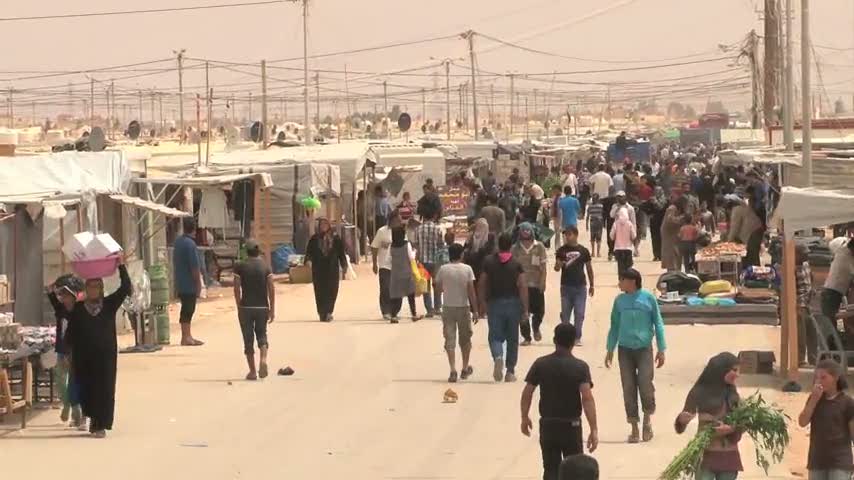

Syrian Crisis - Zaatri Refugee Camps Champs-Elysees
Syrian Crisis - Zaatri Refugee Camps Champs-Elysees
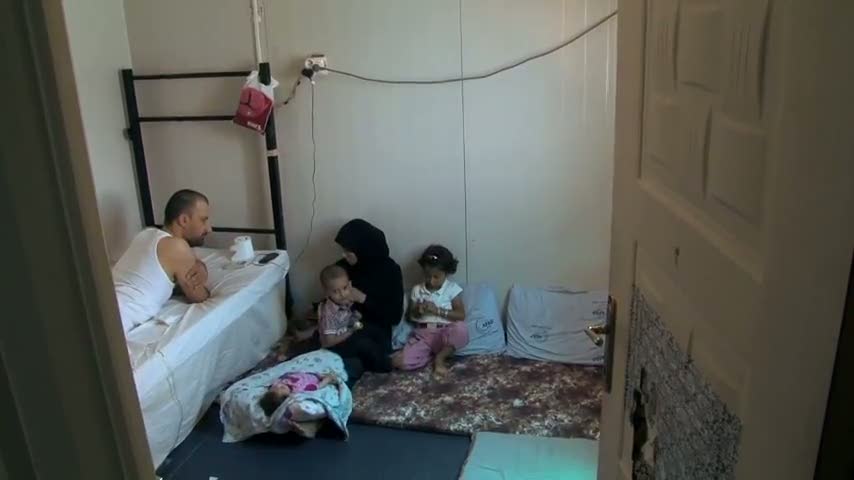

Turkey: Saving Fatmeh
In the care of her aunt, frail little nine-month old Fatmeh struggles to stay alive.
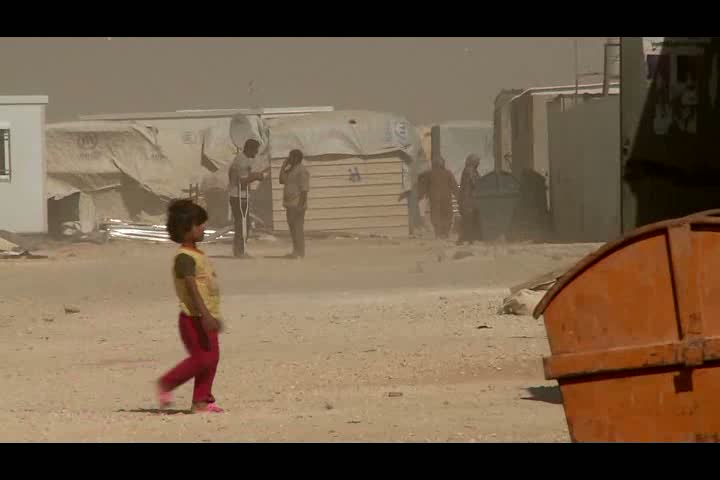

Jordan: Angelina Jolie in conversation with refugees
UNHCR's Special Envoy speaks with two Syrian women who have suffered the ravages of the war in their country.


Lebanon: Shahad's Smile
Four-year-old Shahad has lived through a terrible ordeal – including a bomb attack, a life-threatening injury and flight into exile. But still she smiles.
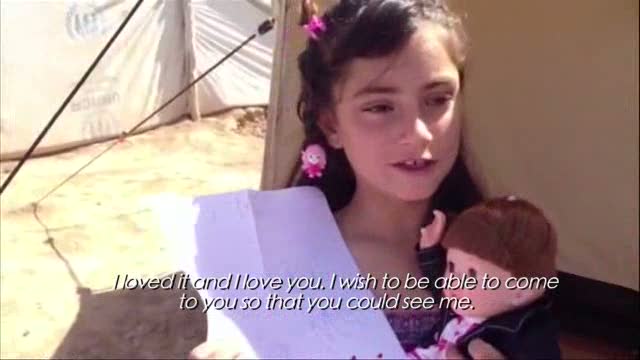

A wish comes true for Syrian girl who left behind the most important thing
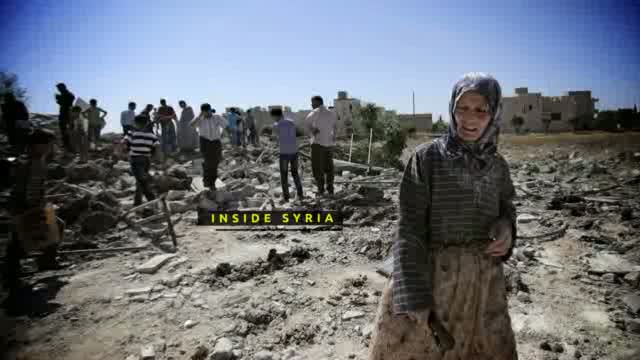

Syria Appeal: Billions Needed
More than 100 humanitarian organizations, including the UN refugee agency, appeal for more than US$4 billion to help millions of Syrians.
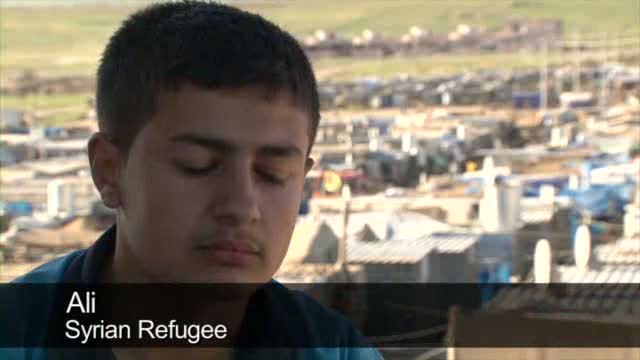

Iraq: Ali's Distant Dream
At the age of 16, Ali is leaving his childhood behind to become sole carer of his grandparents. They all fled to Iraq from Syria, leaving the rest of the family behind.
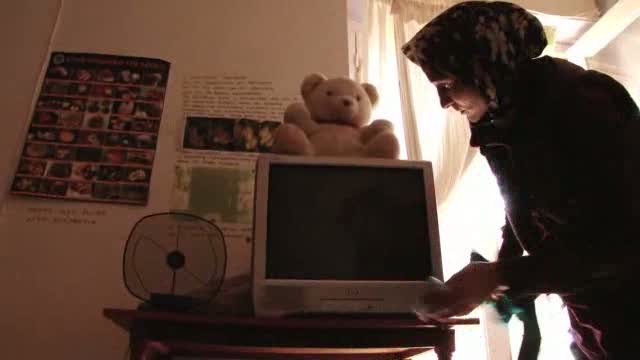

Greece: Syrian Refugees Struggle
As Syrian refugees escape conflict and seek refuge in Greece, they face major new challenges.
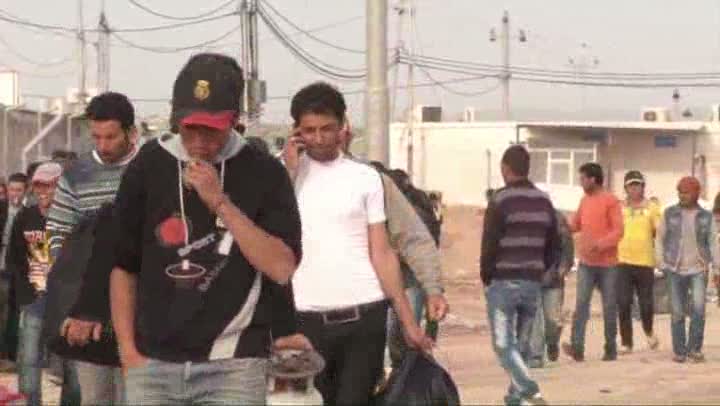

Iraq: A Home for a Syrian Family
Kava and his family arrive at Domiz camp in northern Iraq, traumatized by the conflict in Syria. With the help of UNHCR and its partners, his family has found shelter and a glimmer of hope.


Greece: A Way into Europe
Desperate Syrian refugees take deadly risks to get to Europe.
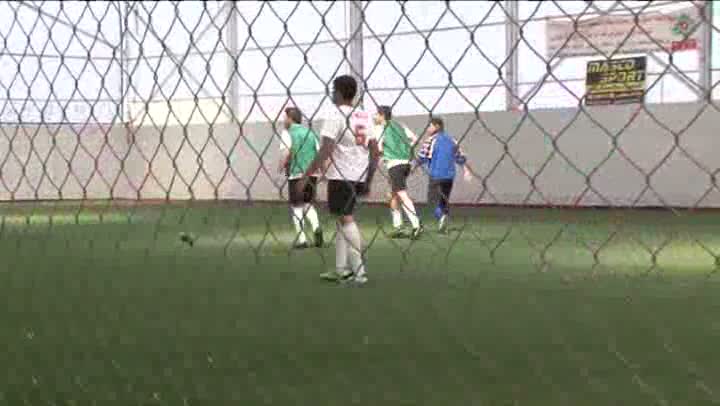

Lebanon: Keep on Playing
A Syrian refugee, once a national player, revives his dream of playing and coaching football.
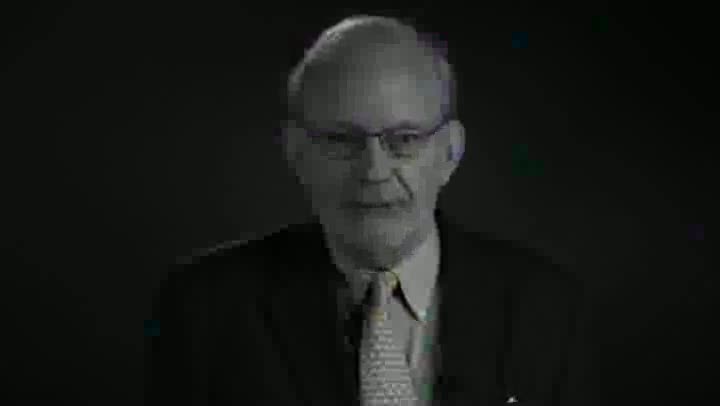

Enough
UN High Commissioner for Refugees António Guterres and the heads of four key UN sister organizations call on governments to find a political solution to the Syria crisis.
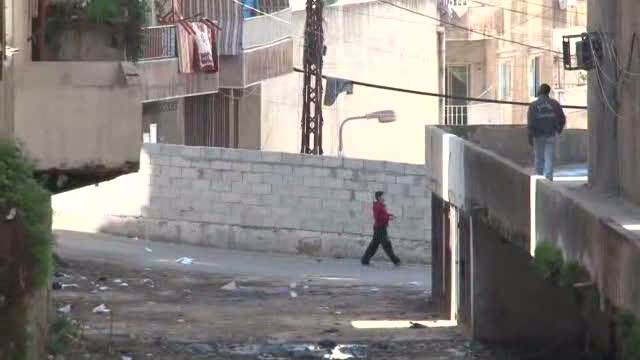

Lebanon: Imad's Story
A Syrian man finds solace in helping other new refugees settle in Lebanon.
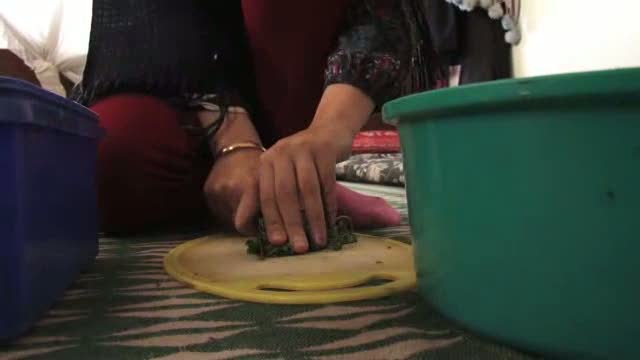

Jordan: Mother–to-be
A young Syrian refugee in Jordan faces the birth of her first child – on her own.
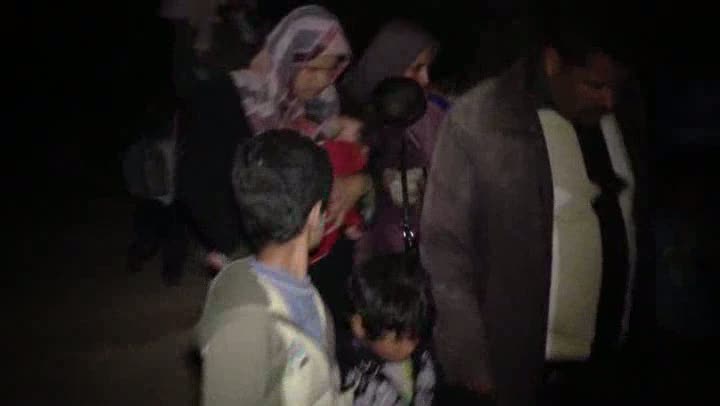

Jordan: Border Exodus
UN High Commissioner for Refugees António Guterres travels to Jordan's border with Syria and watches the nightly inflow of Syrian refugees fleeing conflict in their country.
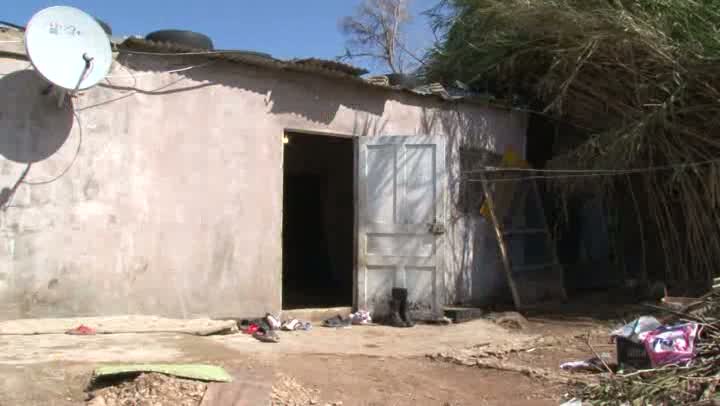

Lebanon: Syria's Millionth Refugee
When Bushra was registered in the Lebanese city of Tripoli on March 6, she became the one millionth refugee from Syria since the crisis there flared almost two years ago.
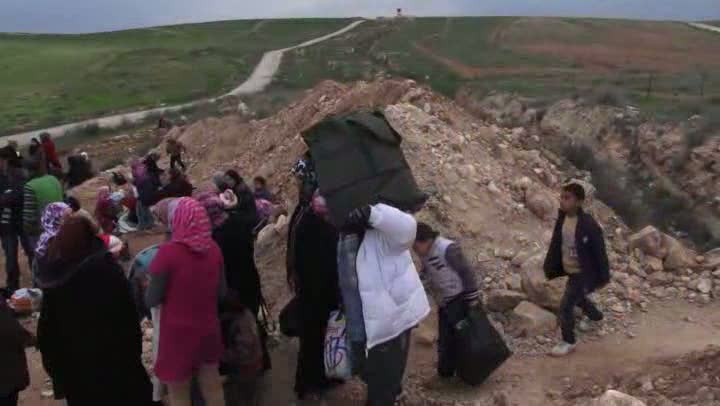

UNHCR: One Million Syrian Refugees
Almost two years after the start of the Syria conflict, the number of Syrian refugees passed the 1 million mark.
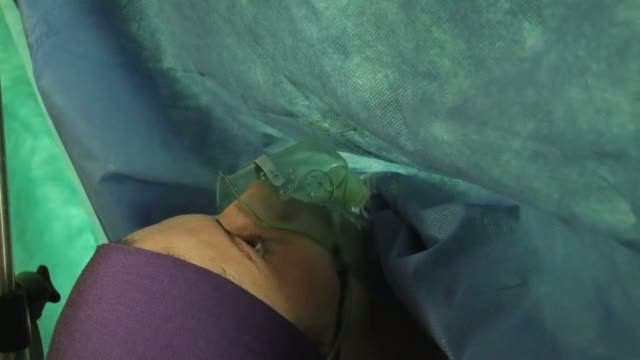

Jordan: Born a refugee
Hundreds of Syrian babies are coming into the world as refugees in Jordan's Za'atri Camp.
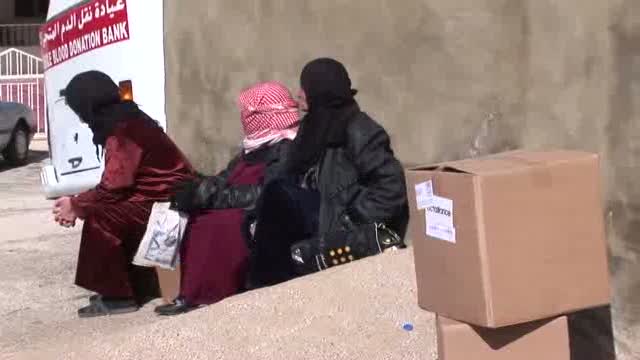

Lebanon: Helping the Refugees
UNHCR and its partners works to help both Syrian refugees and the host communities who have taken them in.
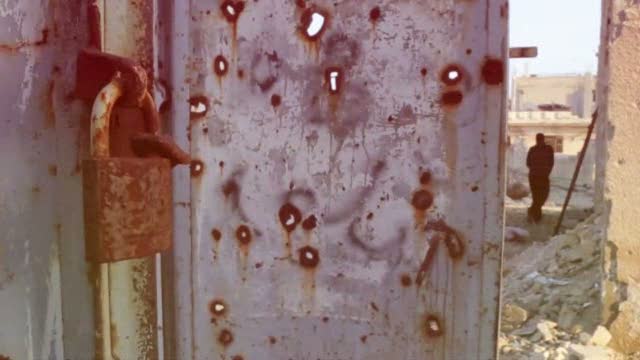

UNHCR: Syria Crisis
The conflict in Syria has sent more than 700,000 people fleeing across borders and displaced many more inside Syria.
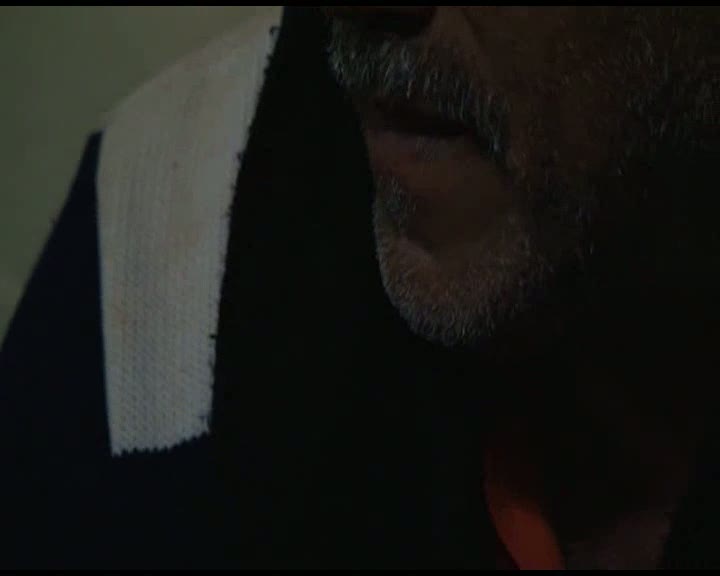

Jordan: Angelina Jolie Visits Border
The UN refugee agency's Special Envoy Angelina Jolie meets a group of newly arrived Syrian refugees during a visit to the Jordan-Syria border.
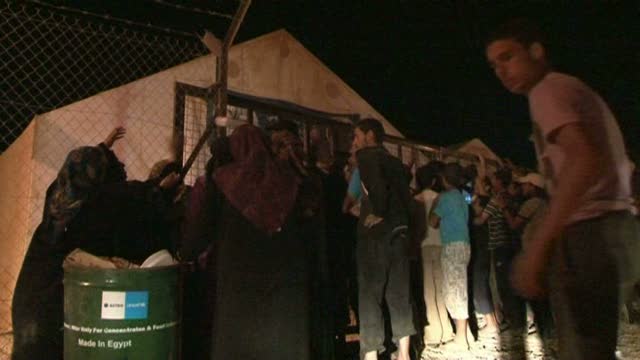

Three Conflicts - Three Crises
UNHCR says a multitude of new refugee crises in Africa and the Middle East are stretching its capacity to respond.
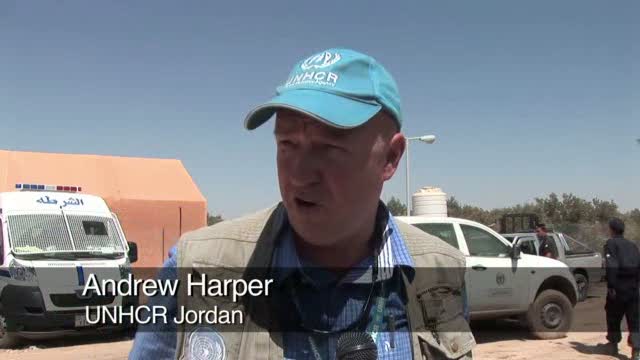

Jordan's Za'atri Camp: Working Round-the-Clock
Since it opened in August, Jordan's Za'atri Camp for Syrian refugees has been a 24 hour-a-day operation.
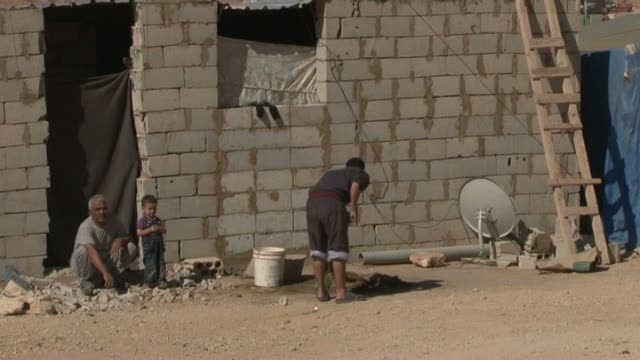

Lebanon: Bekaa Valley Shelter
Refugees continue to flee to neighbouring countries to escape the bitter conflict in Syria. But in Lebanon space is an issue, especially in the Bekaa Valley.
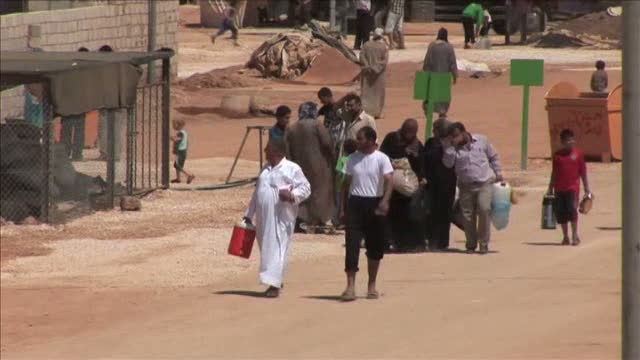

UN Geneva: Syrian Refugee Appeal
UNHCR and dozens of partner organizations up their appeal for Syrian refugees to US$487.9 million and warn that the number of refugees could reach 700,000 this year.
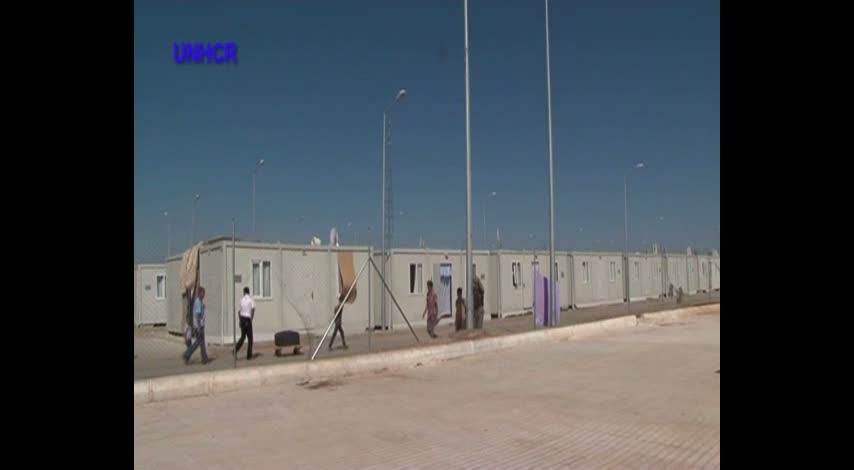

Angelina Jolie visits Syrian refugees in Turkey
On the third leg of their tour, UNHCR Special Envoy Angelina Jolie and High Commissioner for Refugees António Guterres went to Turkey. Their first stop there was in Kilis camp, home to 12,000 Syrian refugees.
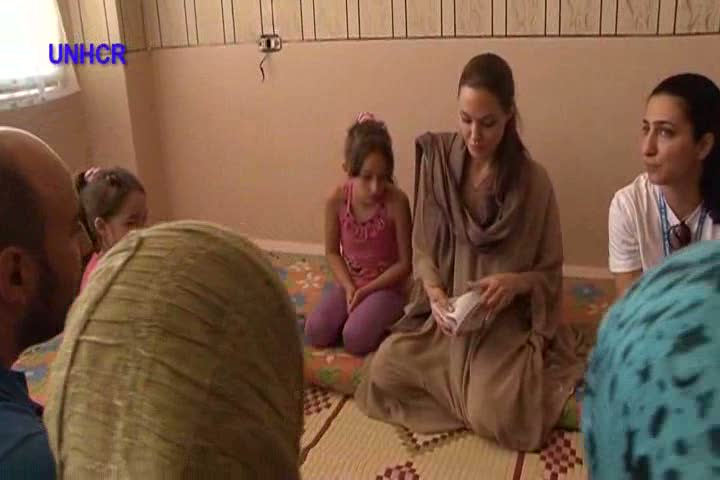

Lebanon: Angelina Jolie Meets Syrian Refugees
UNHCR Special Envoy Angelina Jolie and the refugee agency's chief, António Guterres, talk to Syrian refugees in Lebanon's Bekaa Valley.
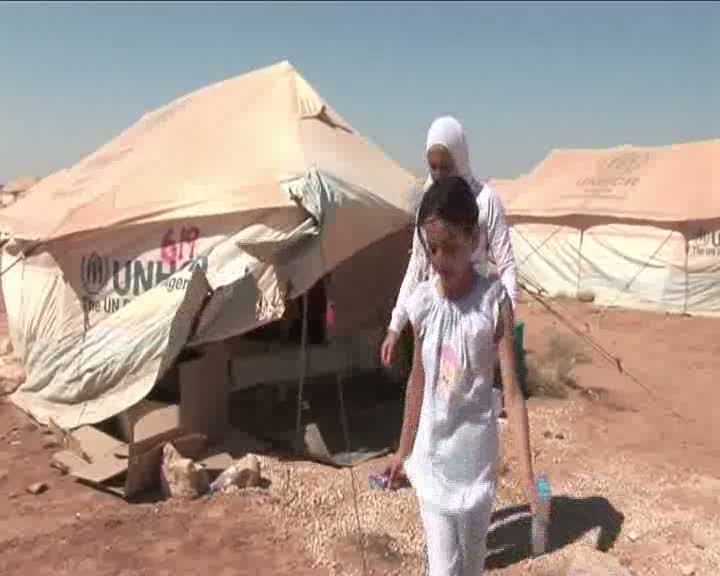

Jordan: Za'atri Children
Children make up almost half of all the Syrian refugees fleeing into Jordan. Experts say they are particularly vulnerable.
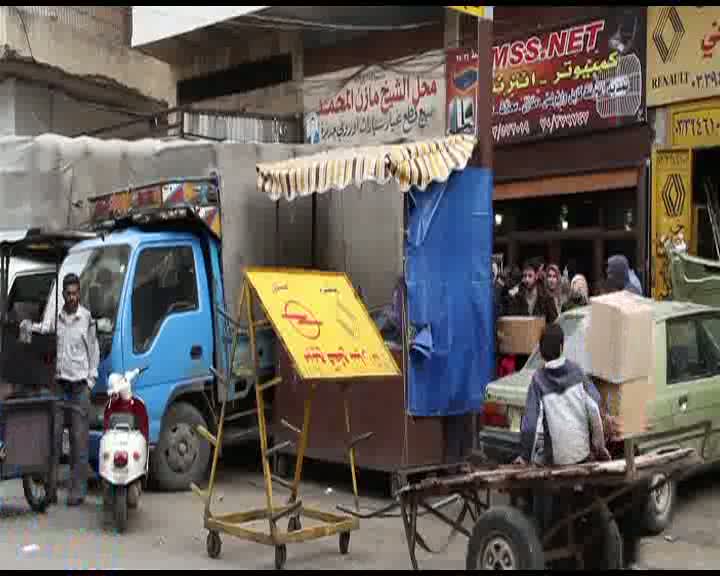

Syrian Refugee Voices
UNHCR joins a call to donors for US$193 million to assist Syrian refugees this year. The revised appeal is a response to the growing numbers of people leaving the country.
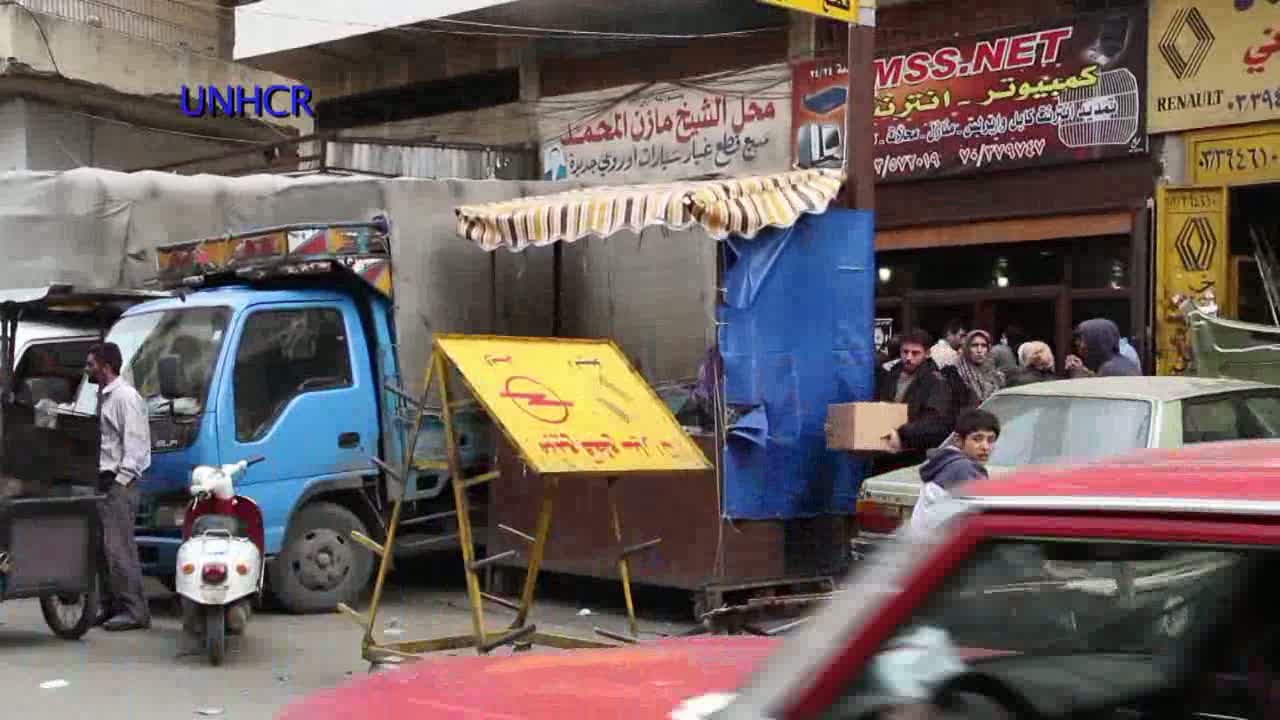

Lebanon: Help for the Refugees
In northern Lebanon, Syrian refugees are given essential assistance by UNHCR and local communities.
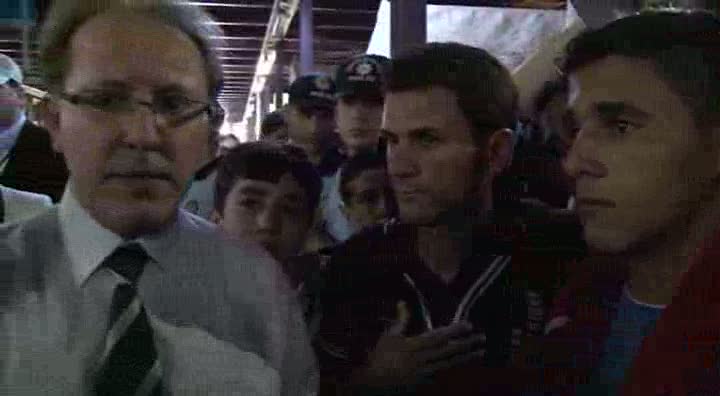

Turkey: Angelina Jolie Meets Syrian Refugees
The UNHCR Goodwill Ambassador travelled to the Turkey-Syria border to hear the stories of Syrian civilians forced to flee their country.
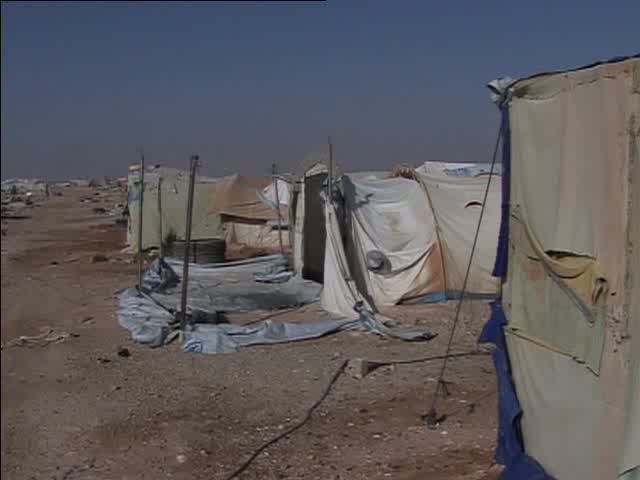

Al Tanf Camp Closes
After years in a bleak no man's land, the remaining residents of the Al Tanf camp are transferred with UNHCR assistance to a more hospitable site inside Syria.
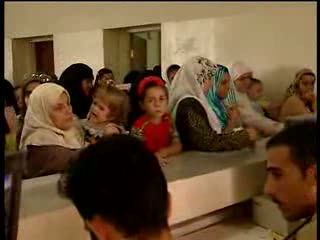

The Struggle To Go To School
It's one of the hardest choices Iraqi refugee families have to make - whether to send their children to school or to work. Even though Syria has opened its classrooms to Iraqi students, a growing number of refugee families simply cannot afford to send their children to school. UNHCR has launched projects to ensure that more Iraqi children access education, including remedial learning programs for those who have missed years of class. For the protection of those interviewed, names have been changed and faces masked.
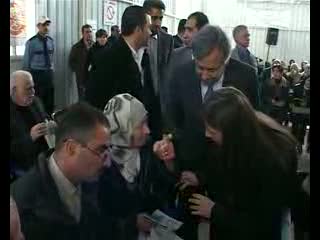

UN High Commissioner for Refugees in Syria
On a recent visit to Damascus, UN High Commissioner for Refugees António Guterres urged donor nations to do more to help host countries like Syria and Jordan look after hundreds of thousands of Iraqi refugees.

